Aoostar R1 and R7 NAS Review
In 2024, the landscape of digital storage and data management is evolving rapidly, influenced heavily by the rising costs of third-party cloud services such as Google Drive, iCloud, and Dropbox. As subscription fees climb, many individuals and businesses are reconsidering their reliance on these external cloud solutions. The increasing financial burden is pushing a growing number of users towards exploring private, on-site server solutions for data storage and management. This shift is driven by the desire for more control over data, enhanced security, and, notably, a more cost-effective long-term storage strategy. In this context, the network-attached storage (NAS) market is witnessing an interesting divergence in user preferences. On one end, there are full turnkey NAS solutions from well-known brands like Synology and QNAP. These devices are valued for their ready-to-use nature, coming with comprehensive software ecosystems and user-friendly interfaces. They are ideal for those who prefer ease and simplicity, offering reliability without the need for deep technical engagement.
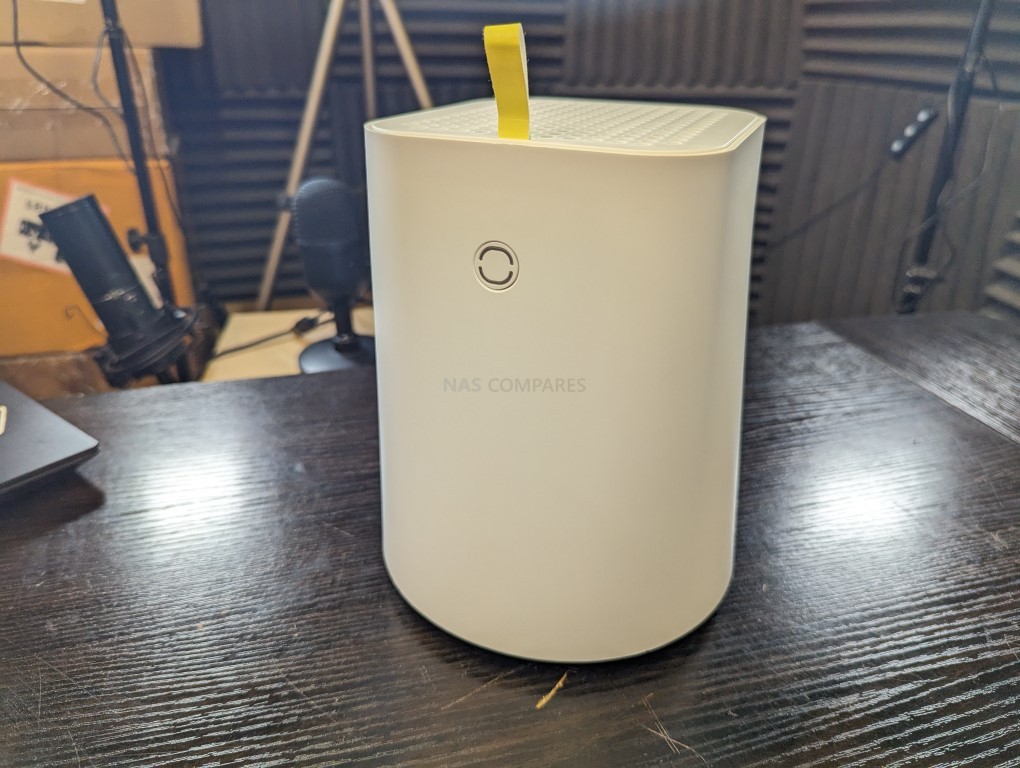
Conversely, the other end of the spectrum is dominated by build-it-yourself NAS solutions, leveraging free software platforms such as TrueNAS Core and TrueNAS Scale. This approach appeals to tech enthusiasts who enjoy customizing their systems. It offers greater flexibility and can be more cost-effective, allowing users to repurpose existing hardware or select components that meet their specific needs. However, this option demands a good grasp of both hardware and software intricacies. Amidst these options, a middle ground is becoming increasingly popular, especially among users who seek a balance between the plug-and-play convenience of turnkey solutions and the customization freedom of DIY systems. This is where products like the Aoostar R1 and R7 NAS units find their relevance. These NAS models aim to provide a compromise, offering the foundational benefits of pre-built systems with opportunities for customization to suit individual preferences. They cater to users who want more control than what standard turnkey solutions offer but prefer to avoid the complexities of a full DIY setup.
| Aoostar R1 2-Bay NAS (Intel N100 Version)
|
Aoostar R7 2-Bay NAS (AMD Ryzen 7 5700U Version) |
||
| Amazon >>> | Aliexpress >>> | Amazon >>> | Aliexpress >>> |
Aoostar R1 and R7 NAS Review – Quick Conclusion
Even on a casual analysis of the Aoostar R1 and R7 NAS units, it is clear that these devices offer a compelling option for those in the market for a NAS solution that strikes a balance between turnkey and DIY systems. The Aoostar R1, with its Intel Processor N100, and the R7, powered by the AMD Ryzen 7 5700U, cater to a diverse range of needs, from basic home storage to more demanding small business applications, providing two solutions that provide significantly higher calibre hardware for the price point than comparable level offerings from Synology and QNAP. On the positive side, both models showcase a thoughtful design that maximizes internal space while maintaining a compact external footprint. Their double-sided micro ITX motherboards and the ability to accommodate multiple storage options highlight a commitment to efficiency and flexibility. The ease of access for upgrades and maintenance, thanks to the removable external casing and internal frame, is another plus, making these units user-friendly. However, there are areas where improvements could be beneficial. The cooling system, particularly in the R7 model, raises concerns, especially considering the potential for heat build-up given the powerful Ryzen processor and the proximity of the CPU fan to the hard drive bays. The absence of 10GbE connectivity in the R7 is a notable limitation for users seeking higher network performance. Additionally, while the pricing of these units is competitive, the lack of ECC memory support in the more powerful R7 model is a missed opportunity to appeal to a broader professional market. The Aoostar R1 and R7 NAS units present a viable middle-ground solution for those looking to move away from third-party cloud services or seeking an alternative to the extremes of the NAS market. While they may not satisfy the most demanding users or those seeking the highest level of customization, they offer a solid balance of performance, ease of use, and expandability.
Where to Buy a Product





![]()
![]()

VISIT RETAILER ➤






![]()
![]()

VISIT RETAILER ➤






![]()
![]()

VISIT RETAILER ➤






![]()
![]()

VISIT RETAILER ➤
 DEAL WATCH – Is It On Offer Right Now? DEAL WATCH – Is It On Offer Right Now?These Offers are Checked Daily
|
Aoostar R1 and R7 NAS Review – Packaging & Retail Kit
The Aoostar NAS arrives in a simple, unadorned box, constructed from single-layer cardboard, which seems to prioritize cost-effectiveness over aesthetics. Inside, the unit is nestled in a thin plastic mold that conforms to its shape, providing basic protection during shipping. This minimalistic approach to packaging reflects a focus on practicality and cost-reduction, a common strategy in the tech industry, especially for budget-friendly products.
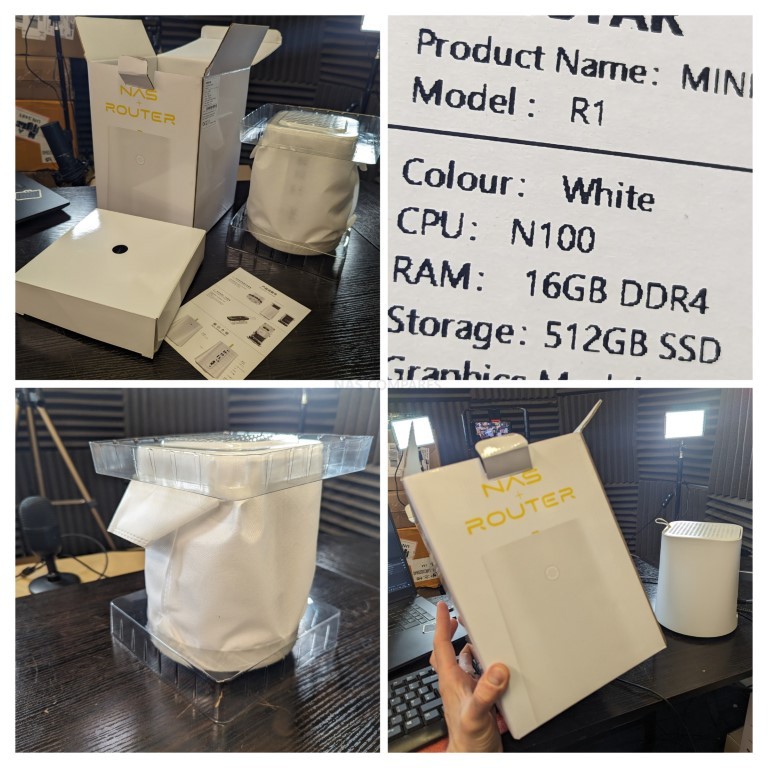
As this device is designed to balance high value with low cost, the choice of packaging materials clearly indicates where the brand has chosen to economize. The packaging is the first aspect where cost-saving measures are apparent, suggesting that Aoostar has allocated resources more towards the device’s functionality rather than its unboxing experience. This decision is not uncommon among technology manufacturers, especially when the goal is to offer competitively priced products without compromising on core features.

Included accessories are practical and sufficient for setting up the device: an external PSU, a setup instruction guide, an HDMI cable, and the Aoostar NAS unit itself. These components provide the essentials needed to get the system up and running right out of the box. The inclusion of a setup guide is particularly helpful for users who may be new to setting up NAS systems, ensuring a smooth and guided installation process.
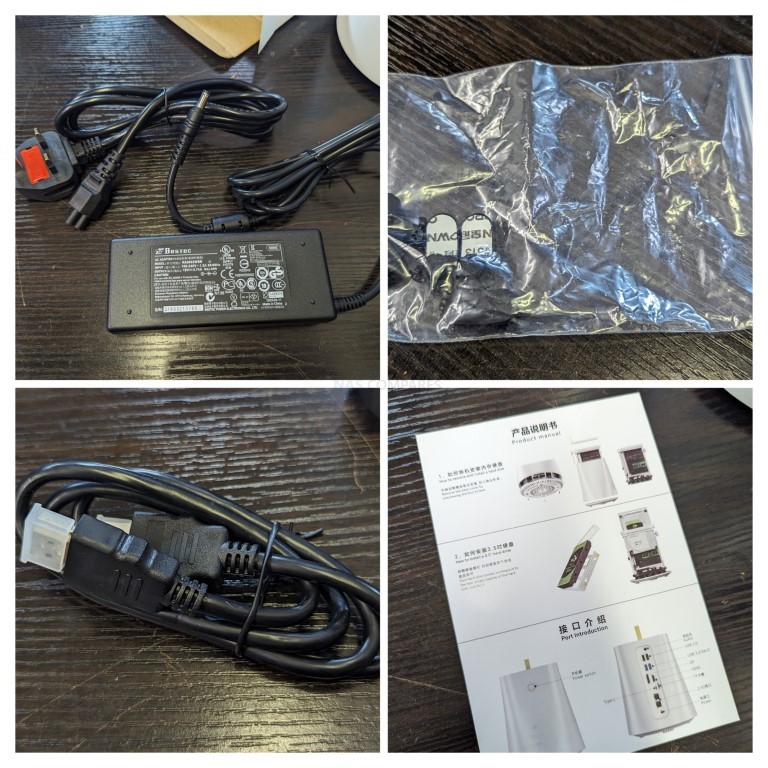
The unit does not come with any additional storage drives, aside from the internal OS NVMe SSD which already has Windows 11 installed. This decision keeps the overall package weight under 1KG, making it lightweight and easy to handle. Customers should be aware that they’ll need to purchase additional storage drives separately if they wish to expand the NAS’s capabilities, especially given its support for up to two 3.5-inch hard drives as previously noted. The absence of an Ethernet cable in the package might seem unusual, but this can be seen as another cost-saving measure by Aoostar. It is likely presumed that many users already possess such cables, or prefer to select cables of a specific length or quality to suit their setup. This omission, while minor, is a reminder of the company’s focus on delivering a high-value product at a lower cost.
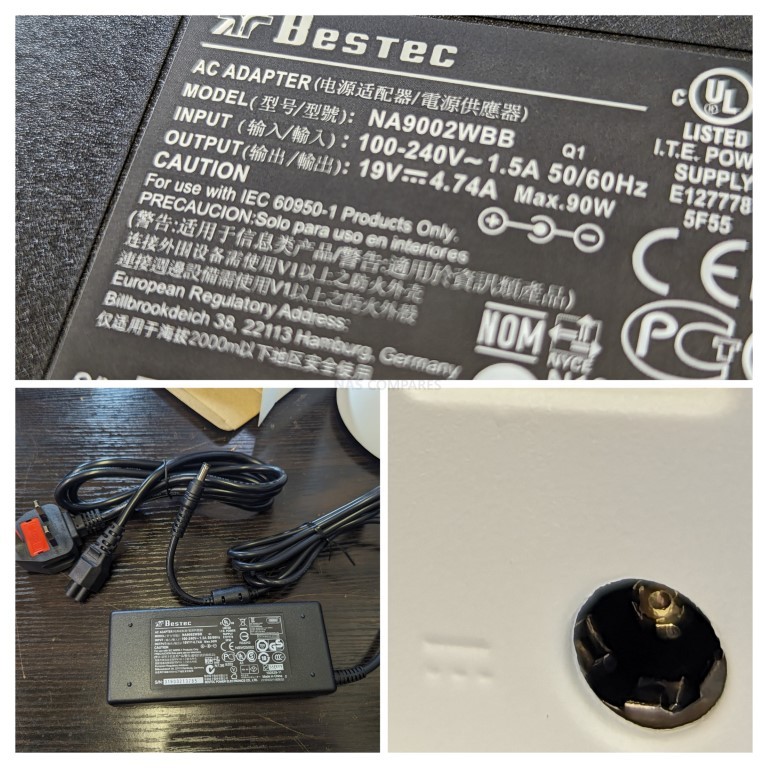
The included external 90W PSU is a fairly standard component and comes with a local regional mains cable attachment. This power supply unit is compatible with the device, ensuring reliable power delivery for optimal performance. The inclusion of the regional mains cable attachment is a thoughtful addition, catering to the specific needs of the user based on their location. However, the 90W rating of the external PSU for the Aoostar R1 seems somewhat excessive, considering the modest power requirements of the N100 CPU inside the NAS. This higher wattage is likely not fully utilized given the CPU’s efficiency and low power consumption. It’s possible that Aoostar uses the same 90W PSU across different models for consistency in manufacturing, which might explain its presence in the R1 kit despite the unit’s lower power needs.
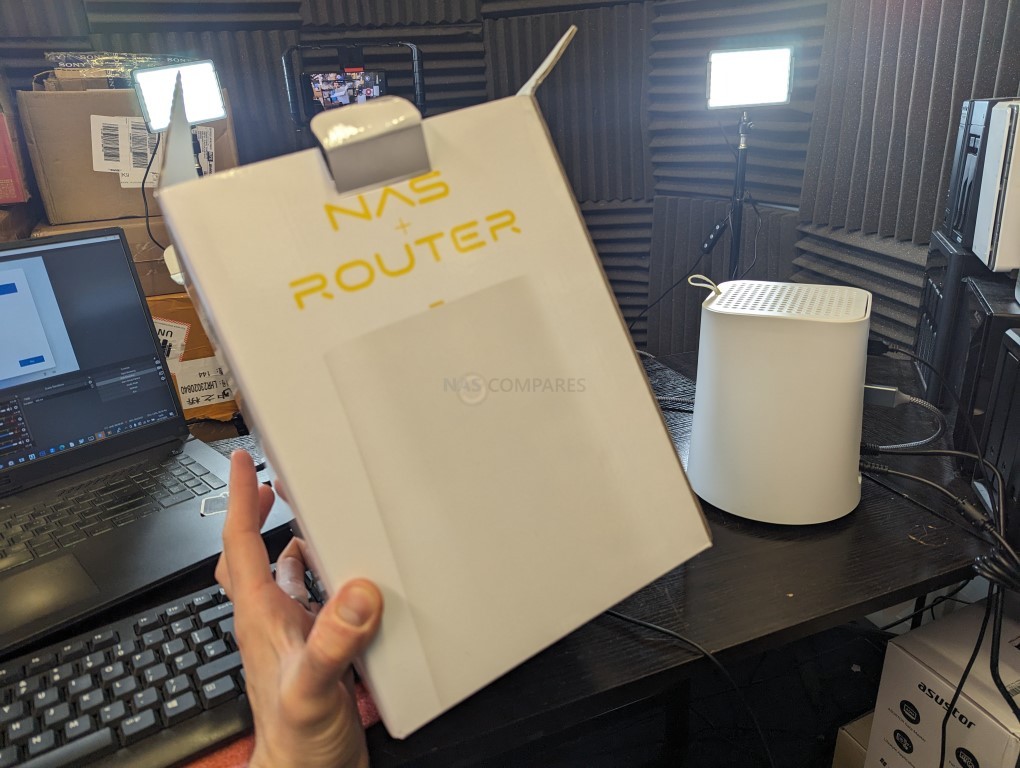
Ultimately, while the Aoostar R1 system will never fully utilize the 90W capacity of the PSU, this choice might reflect a standardized approach in the production line, particularly when considering the similarities with the Aoostar R7. The R7, equipped with a more powerful Ryzen 7 8-core processor, would have higher power demands, possibly justifying the use of a 90W PSU in its kit. This uniformity in power supply units across different models can be a strategic decision to streamline production and reduce costs. Overall, the packaging of the Aoostar NAS might not impress in terms of visual appeal or materials, but the contents of the retail kit are thoughtfully chosen and entirely functional. The focus seems to be on delivering a good quality product with the necessary accessories for operation, rather than on providing a premium unboxing experience. This approach aligns with the brand’s apparent strategy of offering high-value, cost-effective computing solutions.
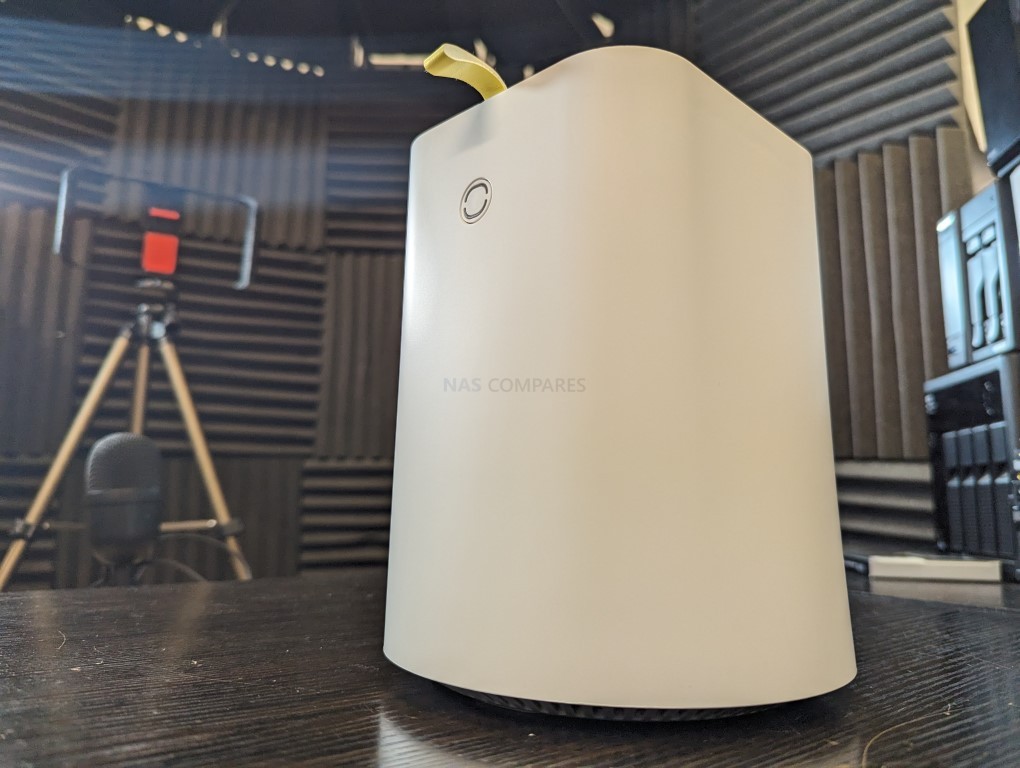
Aoostar R1 and R7 NAS Review – Design
The Aoostar R1’s physical design stands out in the NAS market due to its taller stature compared to many turnkey 2-Bay NAS devices. However, when considering its overall volume, it aligns closely with models like the Synology DS224+ and QNAP TS-264 NAS. This height difference, while noticeable, does not significantly impact the unit’s footprint, making it a viable option for users accustomed to the size of mainstream NAS devices.
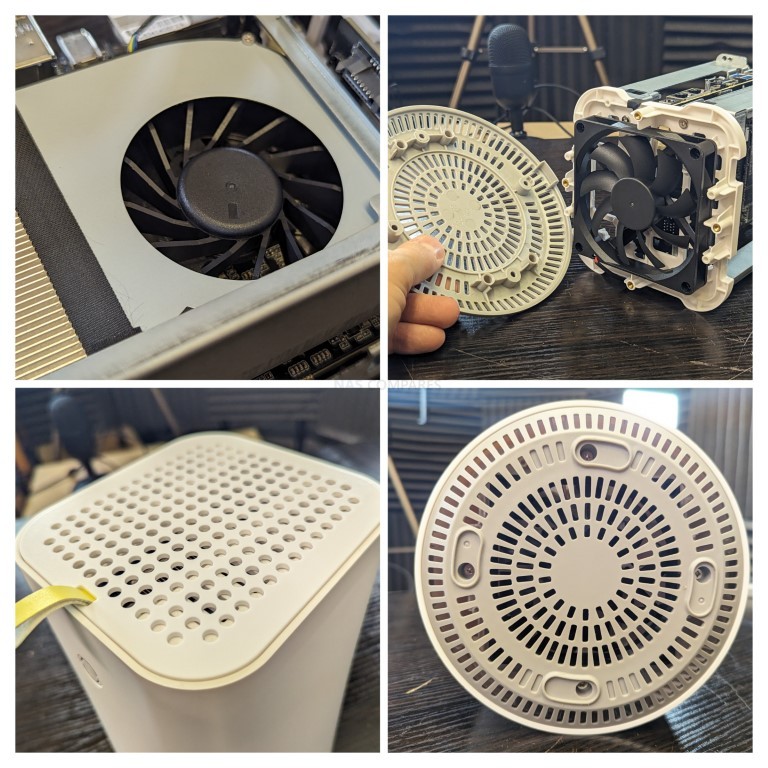
The ventilation system of the Aoostar R1 is meticulously designed, dividing airflow management into three key areas for optimal cooling. The first area is a large base vent equipped with a 90mm fan, which forms the foundation of the unit’s cooling mechanism. This base vent is crucial for maintaining a steady airflow, ensuring that the internal components remain at an optimal temperature during operation.

Adding to the cooling efficiency, there’s a top-mounted and removable vent panel. This panel not only facilitates easy access for maintenance but also enhances the ventilation by covering the additional ventilated drive trays. The removable nature of this panel demonstrates a thoughtful design, allowing for both effective cooling and convenient maintenance.
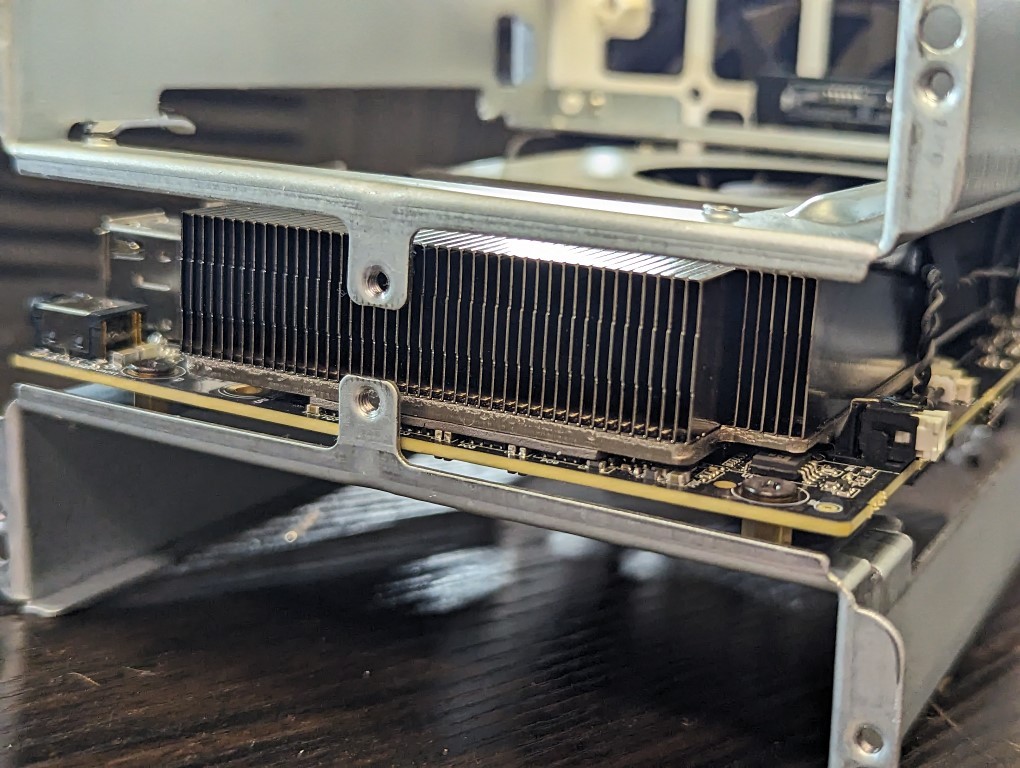
The system also includes a robust combined CPU heatsink and an attached copper fan, strategically positioned to direct airflow towards the top panel. This arrangement enhances heat dissipation, crucial for maintaining system stability and performance. The design indicates a careful consideration of airflow dynamics, ensuring that the heat generated by the CPU is effectively managed. While the overall design is impressive, there are some reservations about the positioning of the CPU and main micro-ITX board, especially in the context of the higher thermal design power (TDP) Ryzen 7 equipped Aoostar R7 model. The concern lies in these components being sandwiched between the HDD bays, which could potentially impact thermal management. However, this is less of an issue in the N100-equipped R1 version, which has a much lower TDP and therefore generates less heat.
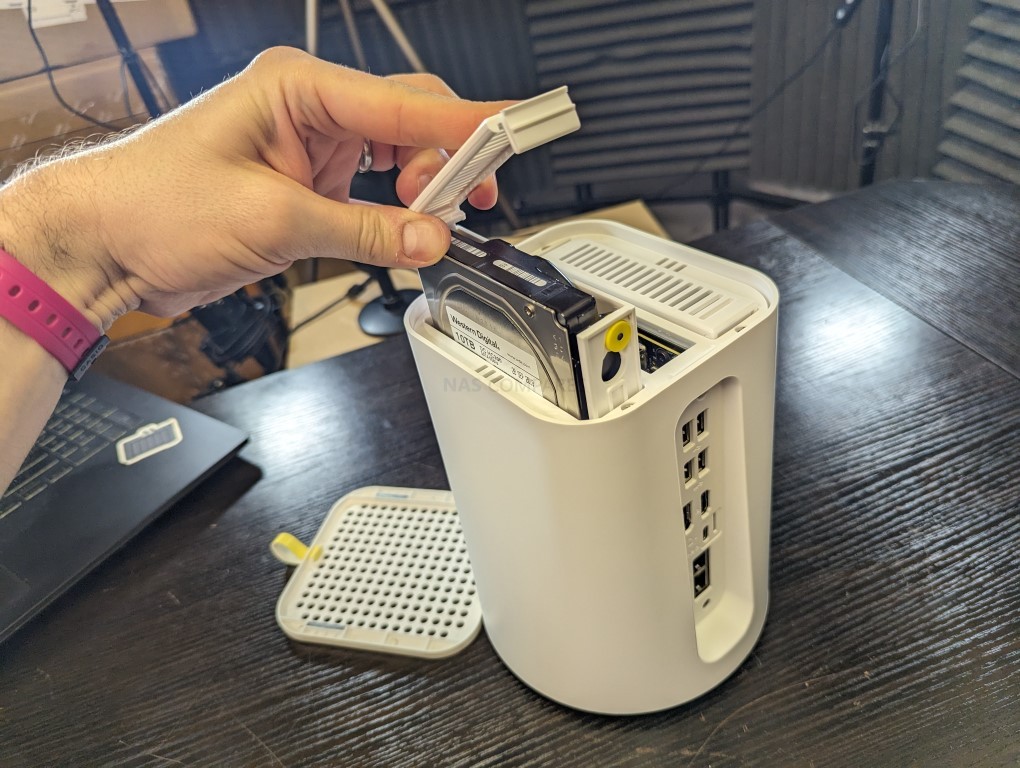
The main storage bays in the Aoostar R1, although functional, have a slightly flimsy construction and utilize removable drive screw grommets that feel somewhat cheap. This aspect of the design might raise questions about durability and long-term reliability. Despite this, the bays serve their purpose and allow for the installation of storage media with relative ease.
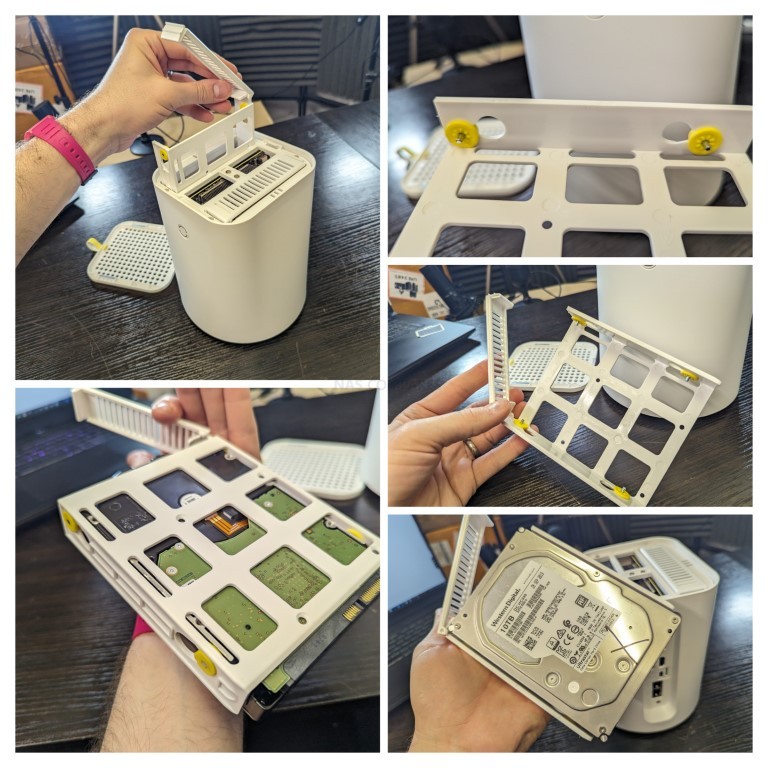
Both 3.5″ and 2.5″ SATA media can be installed in these bays, with the latter requiring additional screws for secure placement. This flexibility in media compatibility is a plus, catering to different storage needs and preferences. The design ensures that the drives, once installed, feel secure in the trays and directly connect to combined data and power SATA connectors internally, eliminating the concern of loose cables. In terms of aesthetic comparison, the Aoostar R1’s design bears a resemblance to the Mac Pro desktop from the mid-2010s or the Drobo Data Transporter. This comparison highlights the unit’s modern and professional appearance, which may appeal to users who appreciate sleek and functional design in their tech devices.
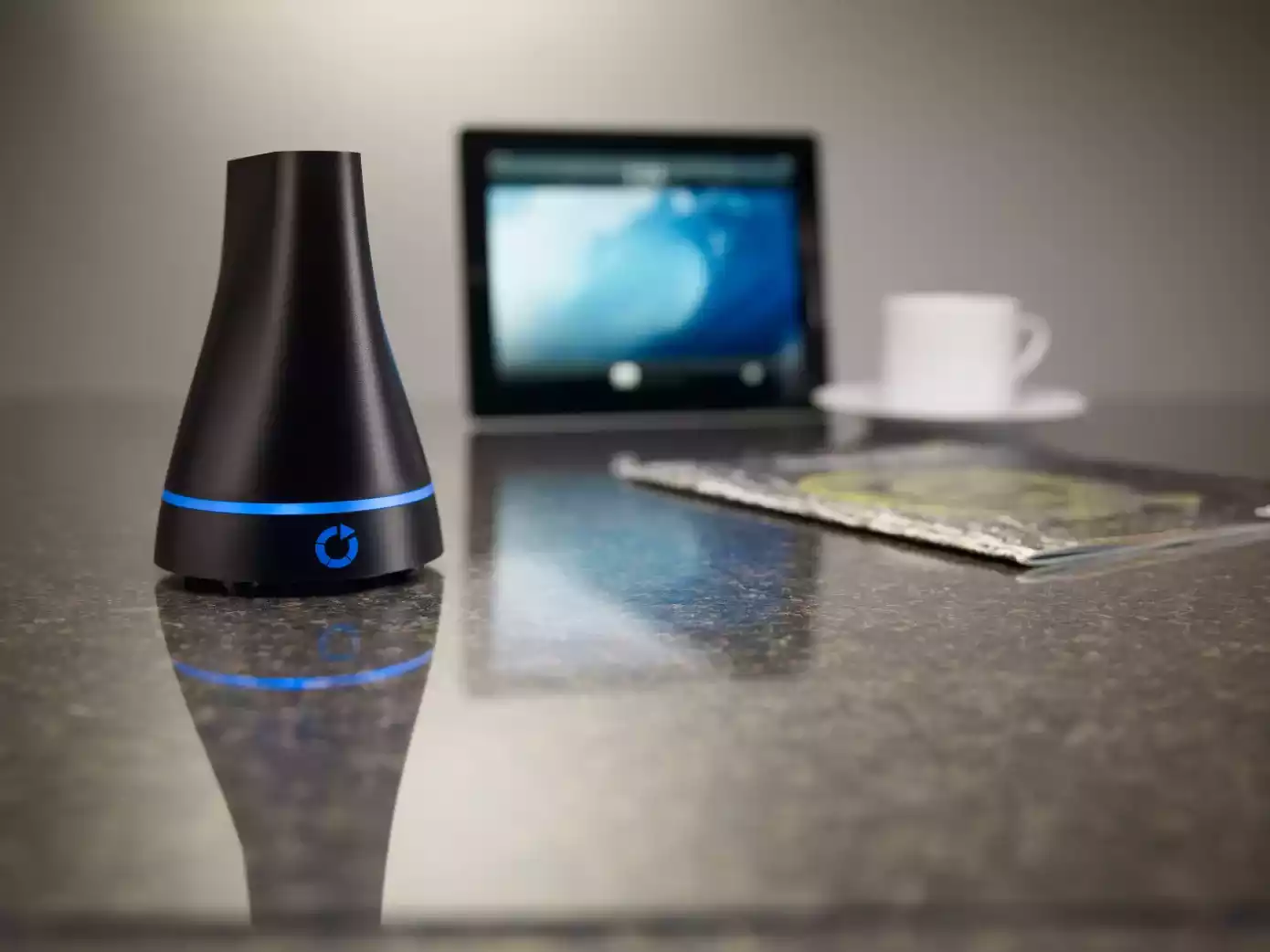
Hot swapping of the 2 SATA storage bays is not supported with the pre-installed Windows 11 software, but this functionality is likely to be achievable with alternative operating systems such as TrueNAS or UnRAID. The flexibility to install different operating systems adds to the device’s versatility, catering to users who require more advanced storage management features. Internally, the Aoostar R1 is equipped with additional storage capabilities, featuring a single M.2 NVMe Gen 3 2280 slot. This slot comes preoccupied with the OS drive, highlighting the unit’s readiness for immediate use. The inclusion of an M.2 slot offers fast data transfer speeds and efficient storage, enhancing the overall performance of the device.
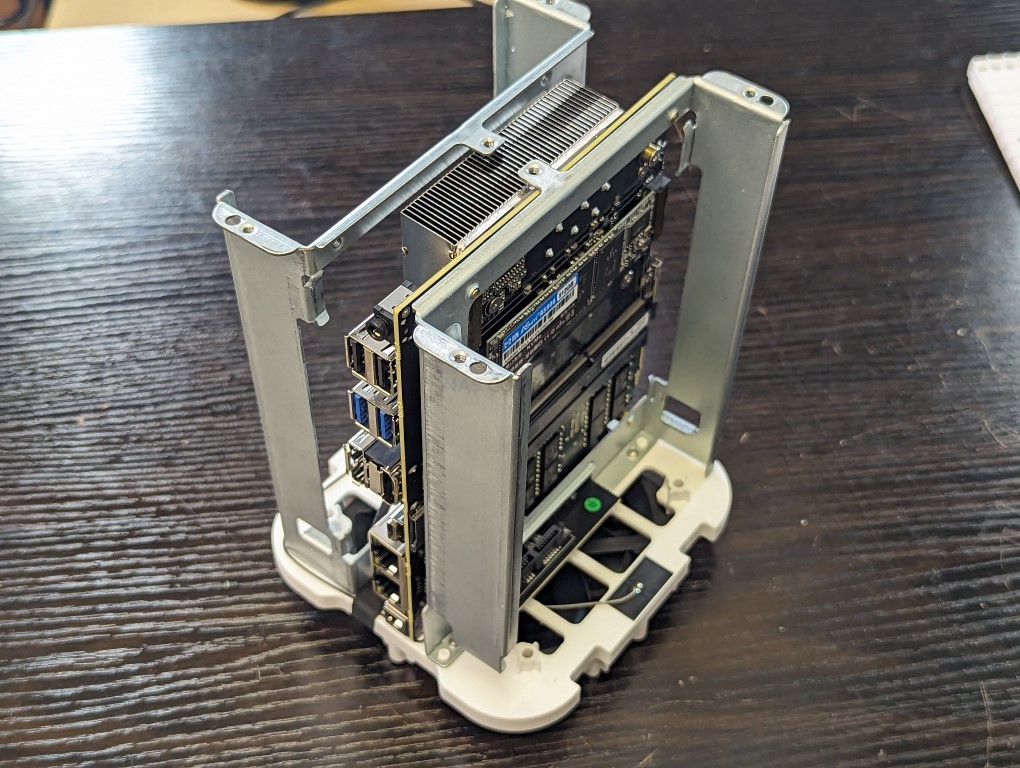
The Aoostar R7 NAS, on the other hand, benefits from an additional M.2 NVMe SSD 2280 slot, also supporting Gen 3. This extra slot in the R7 model provides greater flexibility and capacity for storage expansion, making it a more suitable choice for users with higher storage demands. Finally, the base 90mm fan of the Aoostar R1 operates very quietly, contributing to a pleasant user experience. However, during operation, the CPU fan becomes audible, even under light use. This noise level is possibly due to the motherboard’s placement directly between the SATA bays, which may affect airflow and consequently the cooling efficiency of the CPU fan.
Aoostar R1 and R7 NAS Review – Ports and Connections
The Aoostar R1 and R7 models boast identical port configurations, a design choice that simplifies user understanding across the product line. This uniformity in ports ensures that users can have a consistent experience regardless of which model they choose. The similarity in port offerings across these models reflects a streamlined approach to product design, making it easier for users to transition between different models if needed.
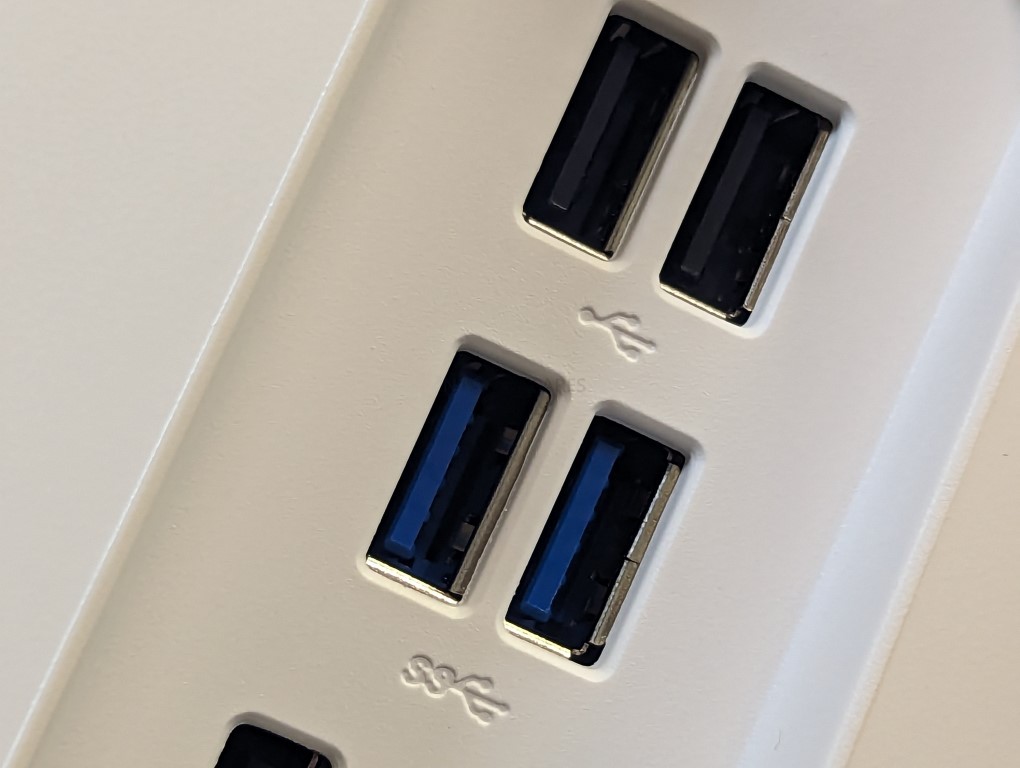
Among the available ports, there are 2 USB 3.2 Gen 2 Type A 10Gb/s ports and a USB-C port, providing high-speed data transfer capabilities. These ports are ideal for connecting external storage devices, high-resolution cameras, or other peripherals that benefit from fast data transfer rates. The inclusion of a USB-C port also adds a level of future-proofing, as it’s becoming the standard for many modern devices.
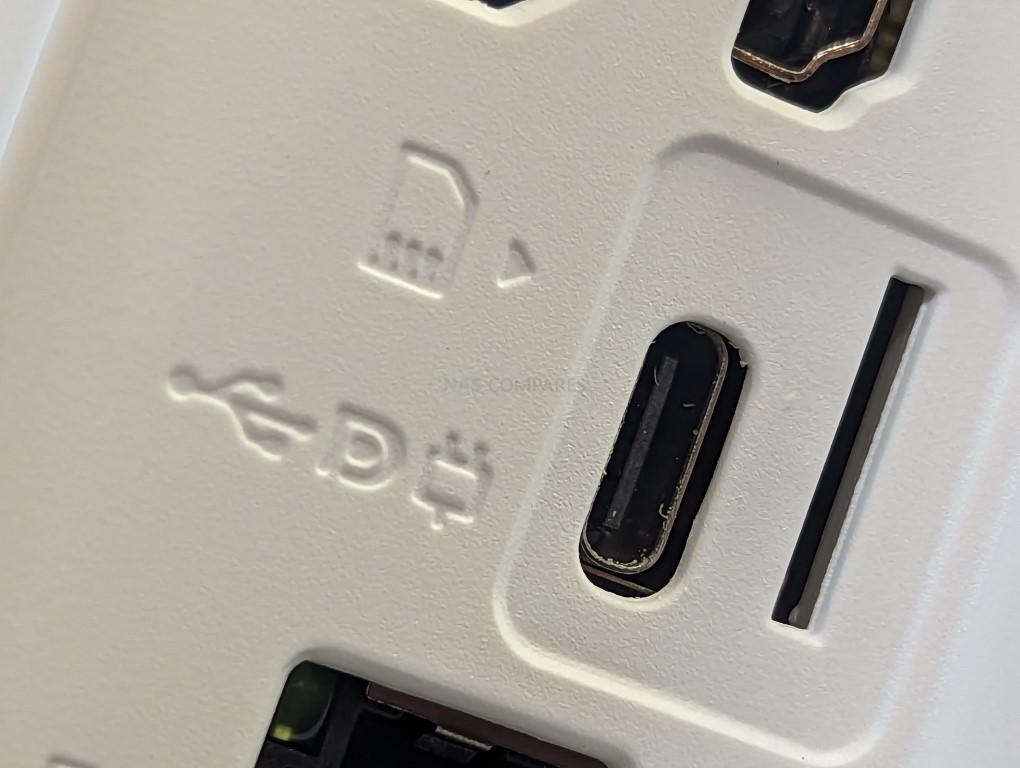
Additionally, there are two USB 2.0 ports, which are most suitable for connecting peripherals like a keyboard and mouse, especially when using the NAS with its visual outputs. These ports, while not suitable for high-speed data transfers, are perfectly adequate for input devices. Their inclusion ensures that essential peripherals can be connected without occupying the more valuable high-speed ports.
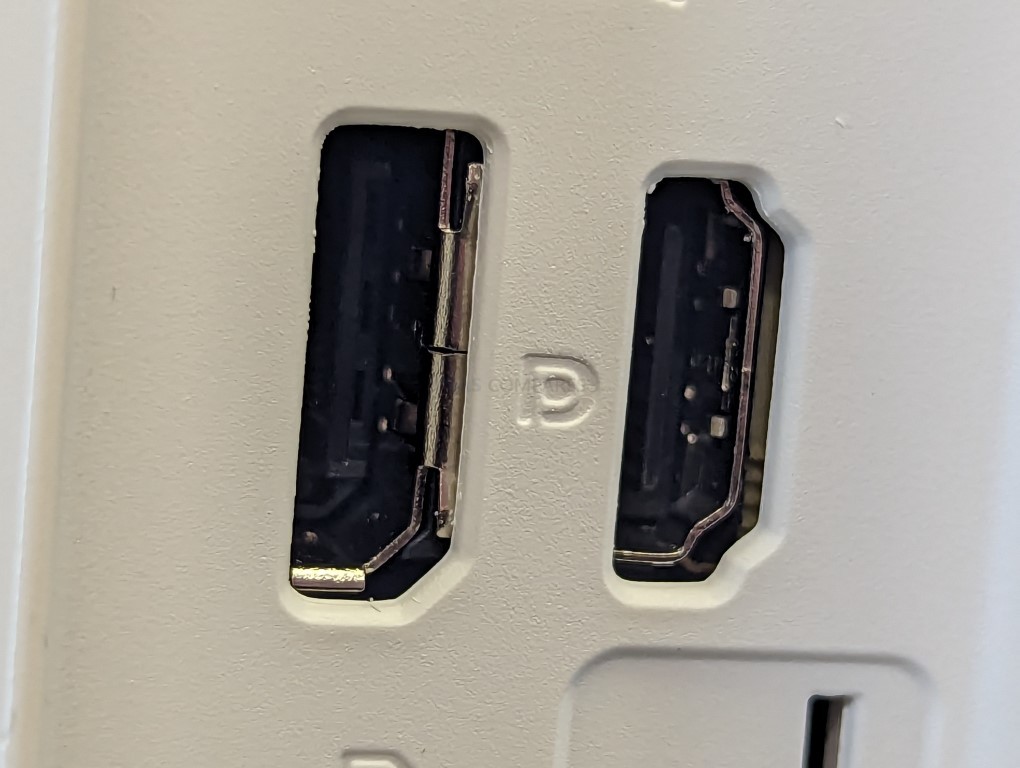
Regarding visual output, the units are equipped with an HDMI 2.0 and a DisplayPort 1.4 connection, both capable of supporting 4K resolution at 60FPS. This capability is particularly beneficial for users who need high-definition output, such as for media servers or digital signage. The ability to deliver 4K content smoothly makes these NAS units versatile in various settings, from home entertainment to professional environments. The support for KVM (Keyboard, Video, Mouse) is dependent on the NAS software in use and its capability to support an external graphical user interface. The Windows 11 software included with these units is a standard desktop operating system, not a server version of Windows. This choice implies that the NAS is intended for users who are comfortable with a familiar, user-friendly interface rather than a specialized server environment.

The default network connection on the Aoostar R1 consists of 2x 2.5GbE ports, which also support auto-negotiation with 1GbE networks. This feature ensures compatibility with a wide range of network speeds and environments, making it a flexible choice for different types of network setups. The 2.5GbE connectivity offers a balance between high-speed data transfer and compatibility with existing network infrastructures.
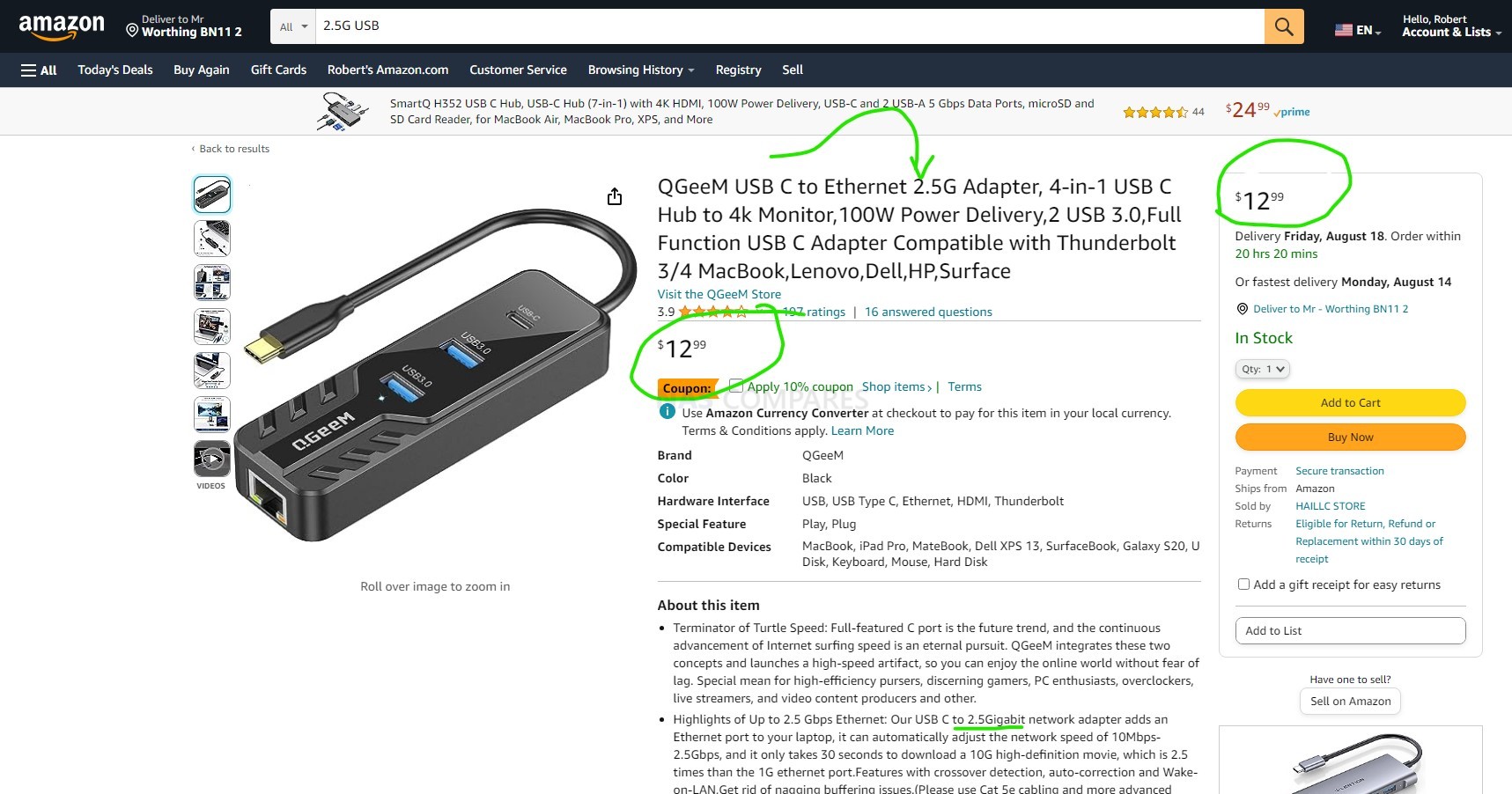
Users have the option to expand network capabilities using various USB-to-2.5GbE adapters, which typically cost between $15-25. These adapters provide an affordable way to add more network connections, enhancing the unit’s functionality in complex network environments. This flexibility is particularly useful for users who need to integrate the NAS into a network with specific requirements. The absence of a 10GbE port is understandable in the modestly powered Aoostar R1, equipped with an N100 processor, but it is a more noticeable limitation in the higher-powered Ryzen 7 8-Core Aoostar R7. Ideally, it would have been preferable to have a 10GbE port, possibly by repurposing the internal additional M.2 NVMe port to an external 10GbE connection through an adapter or motherboard modification. Such a feature would significantly enhance the data transfer capabilities of the R7 model, making it more suitable for environments with higher network performance requirements.
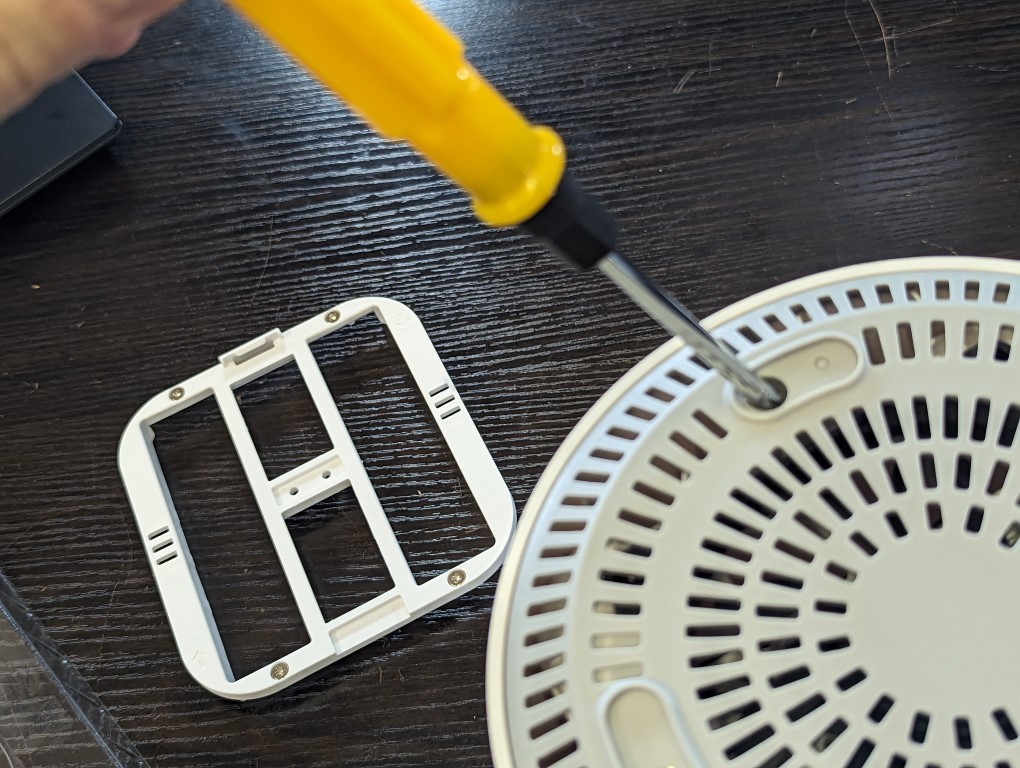
There is no PCIe upgradeable slot in these models, and the full extent of the PCIe lanes afforded to this architecture is already maximized. This limitation is understandable, considering the compact form factor and the intended use case of these NAS units. While it limits the potential for hardware upgrades, it also ensures a more stable and reliable system by design. Overall, it’s evident that the physical connectivity of the Aoostar R1 and R7 models aligns with the rest of the Aoostar N1 and N7 Mini PC series, albeit with modifications tailored towards a 2-Bay NAS system. This consistency in design across different models reflects a strategic approach to product development, focusing on creating versatile, user-friendly devices that cater to a range of needs and preferences.
Aoostar R1 and R7 NAS Review – Internal Hardware
Accessing the internal hardware of the Aoostar R1 is a straightforward process, involving the removal of four screws located at the base panel. This user-friendly design is indicative of Aoostar’s commitment to making their devices easily serviceable. Once the screws are removed, the external casing can be easily lifted off, revealing the inner components.

Sliding out the internal frame, the double-sided micro ITX motherboard becomes visible, showcasing the compact and efficient design of the Aoostar R1. This reveals the intricate engineering that has gone into maximizing the use of space within the unit. The double-sided nature of the motherboard is a clever use of space, allowing for more components to be fitted into the compact NAS unit.
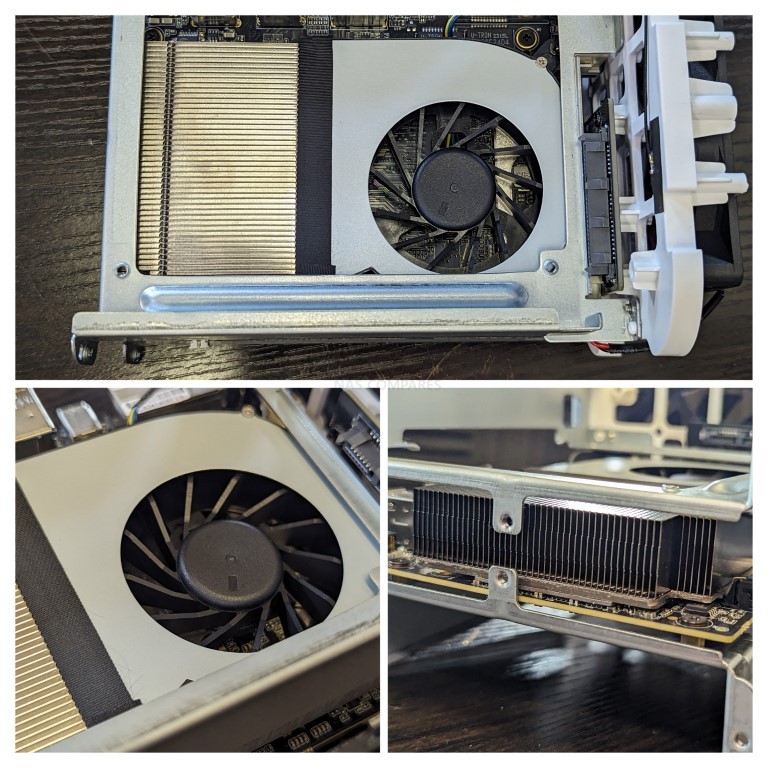
On one side of this motherboard, the combined CPU cooler and heatsink are prominently featured. This setup is crucial for maintaining optimal operating temperatures and ensuring the longevity and reliability of the CPU. The integration of the cooler and heatsink into a single unit demonstrates a focus on efficient thermal management within the compact form factor of the NAS.
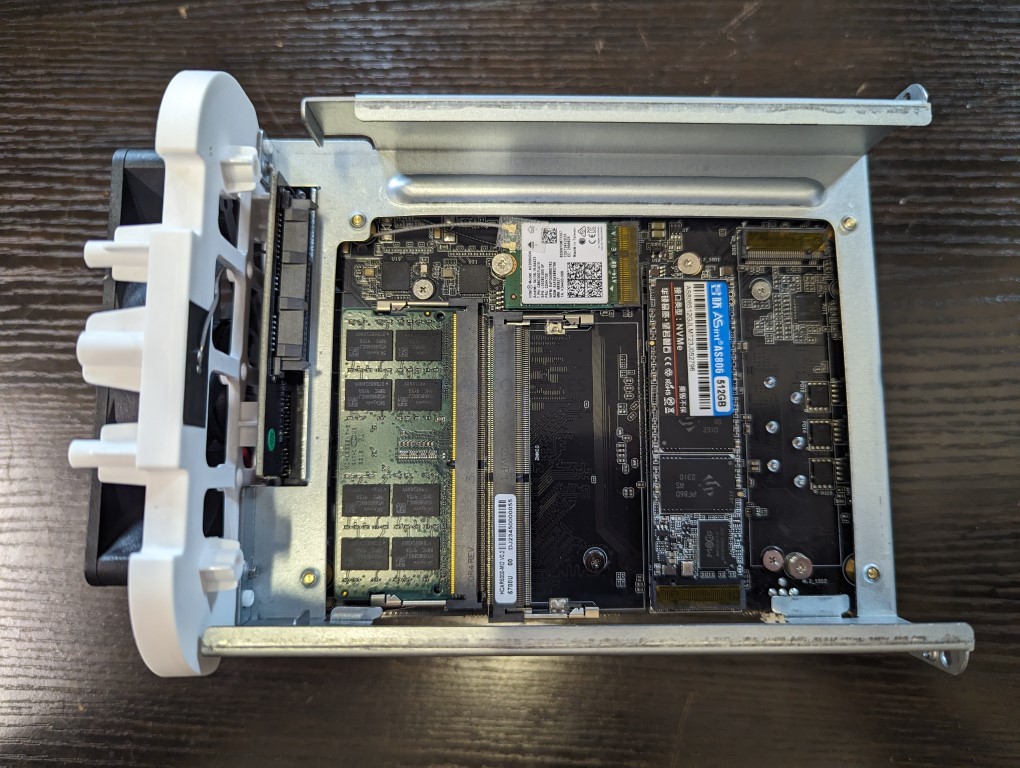
Here are the side-by-side specifications of the Aoostar R1 and R7, which vary in price by around $100-150 depending on your configuration:
| Specification | Aoostar R1 | Aoostar R7 |
|---|---|---|
| CPU | Intel Processor N100 quad-core | AMD Ryzen 7 5700U, 8 cores/16 threads |
| Graphics | 24EU Intel HD graphics @ 750 MHz | AMD Radeon Graphics |
| RAM | Up to 16GB DDR4-3200 (1x slot) | Up to 64GB DDR4-3200 (2x slots) |
| Storage | 512GB M.2 2280 NVMe SSD (optional) | 512GB M.2 2280 NVMe SSD (optional) |
| Additional M.2 Slot | None | 1 (M.2 2280, NVMe) |
| Networking | 2x 2.5GbE, WiFi 6 | 2x 2.5GbE, WiFi 6 |
| USB Ports | 2x USB 3.2 Gen 2, 2x USB 2.0 | 2x USB 3.2 Gen 2, 2x USB 2.0 |
| Video Output | HDMI 2.0, DisplayPort 1.4 | HDMI 2.0, DisplayPort 1.4 |
| Power Supply | 90W external PSU | 90W external PSU |
| Dimensions | 162 x 162 x 198 mm | 162 x 162 x 198 mm |
| Weight | Approx. 1kg | Approx. 1kg |
There are concerns about the placement of the CPU fan in the Aoostar R1, as it is positioned directly above a 3.5″ hard drive. This configuration could potentially lead to the intake of warm air into the cooler, affecting its efficiency, or it might limit the dissipation of heat from the heatsink. Such a design choice may have implications for the thermal management of the device, especially under heavy use.
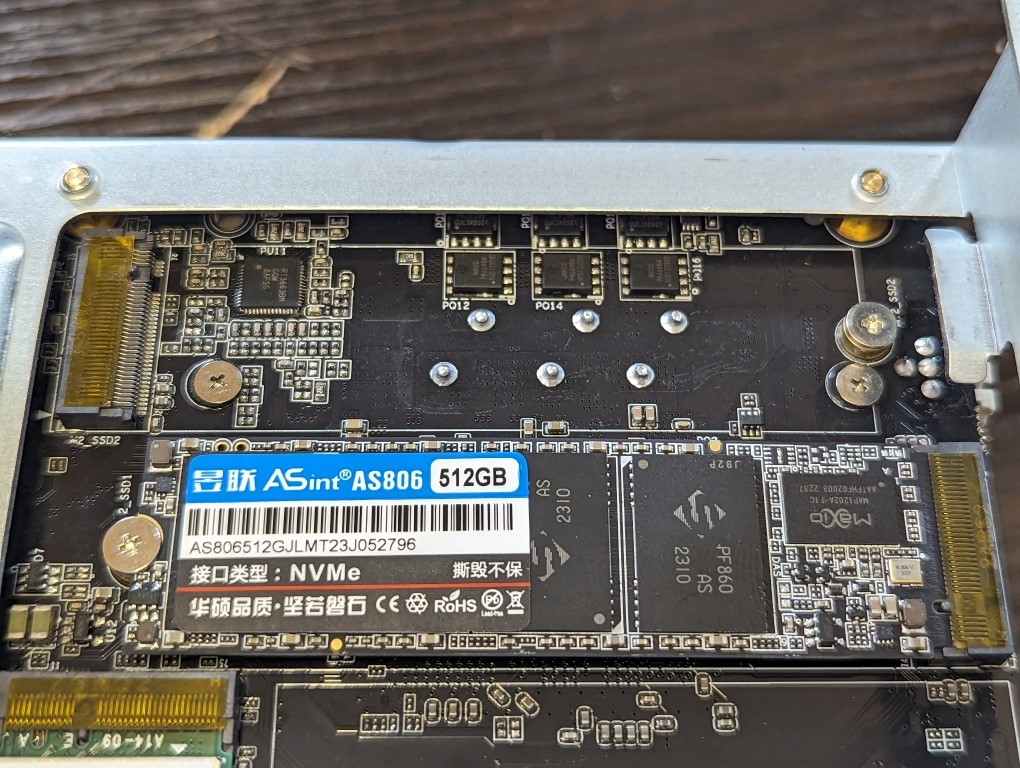
Flipping the motherboard reveals the M.2 NVMe storage bay(s) in the R1 and R7 models, respectively. The R1 model includes a single M.2 NVMe slot, while the R7 benefits from an additional slot. This difference in storage expansion capabilities highlights the R7’s suitability for more demanding storage requirements. Each model comes with two SODIMM DDR4 memory slots, offering flexibility in memory configuration. Customers have the option to purchase the device without memory, or they can opt for configurations with 16GB or 32GB (2x 16GB) of 3200MHz DDR4 RAM. This choice allows users to tailor the memory to their specific needs and budget.
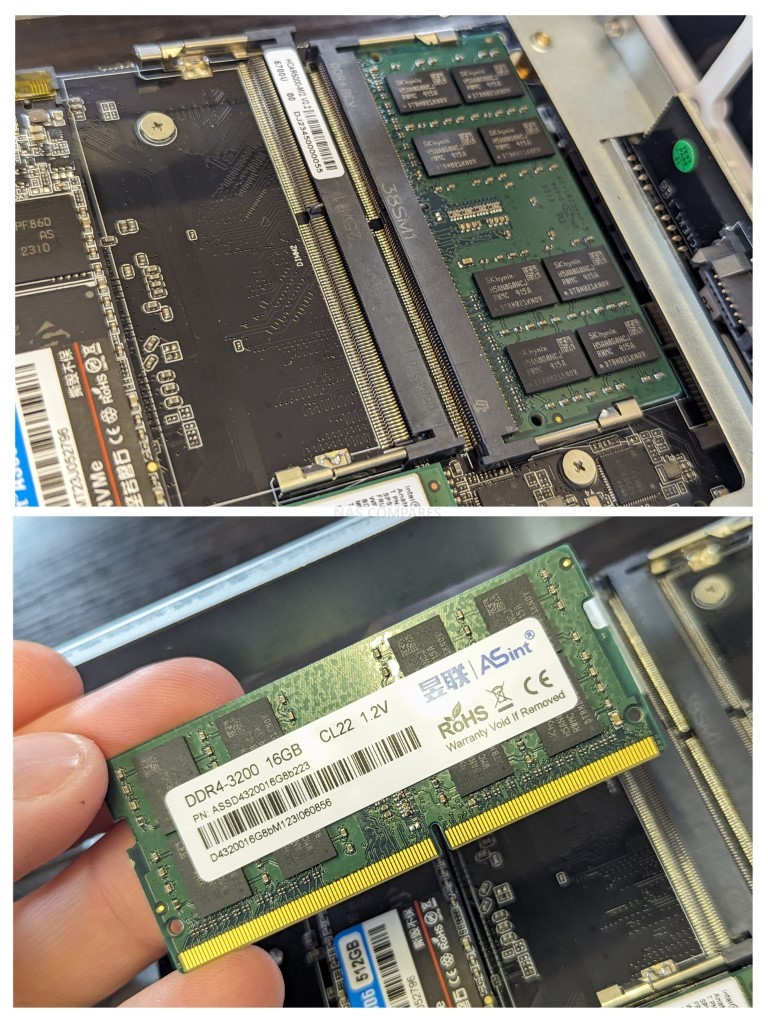
It’s important to note that the system does not support ECC Memory, which, while not critical for this scale of operation, could have been a beneficial feature in the more powerful R7 unit. ECC Memory offers improved data integrity, which is particularly useful in environments where data accuracy is paramount. However, for most home and small office applications, the lack of ECC Memory is not a significant drawback. The Aoostar units come equipped with WiFi 6 support, delivered via an M.2 AX Intel WiFi module. This modern wireless standard provides faster and more reliable internet connectivity. The WiFi module feeds into two internal antennas located on the base of the frame on either side, ensuring optimal signal reception and transmission.
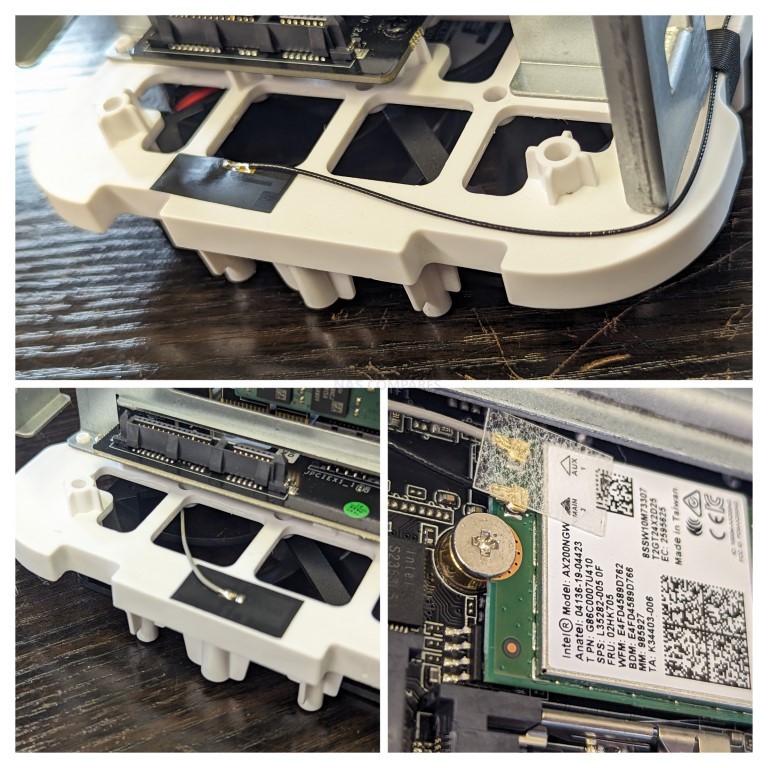
This integration of advanced networking capabilities into the Aoostar’s design is an impressive modification of the existing architecture of other Aoostar mini PCs, now adapted for a 2-Bay NAS system. The transformation from a standard mini PC to a NAS system involves more than just adding hard drive bays; it requires a thoughtful reconfiguration of internal components to support NAS functionalities effectively. However, concerns about the physical placement of the motherboard persist, especially considering the Aoostar models are designed for 24/7 operation. While the systems will experience extended idle periods, during busy times, the CPU could potentially experience performance throttling due to insufficient cooling. This concern is more pronounced in the R7 model, equipped with a more powerful Ryzen 7 processor, which generates more heat and thus requires more efficient cooling.

Both the Intel N100 in the Aoostar R1 and the Ryzen 7 in the R7 feature multi-core architectures and integrated graphics. However, the Vega graphics in the R7 are notably superior in terms of performance and capabilities. This difference in graphics processing power makes the R7 model more suitable for tasks that require more robust graphical processing, such as media transcoding or light gaming.
Aoostar R1 and R7 NAS Review – Verdict and Conclusion

Even on a casual analysis of the Aoostar R1 and R7 NAS units, it is clear that these devices offer a compelling option for those in the market for a NAS solution that strikes a balance between turnkey and DIY systems. The Aoostar R1, with its Intel Processor N100, and the R7, powered by the AMD Ryzen 7 5700U, cater to a diverse range of needs, from basic home storage to more demanding small business applications, providing two solutions that provide significantly higher calibre hardware for the price point than comparable level offerings from Synology and QNAP. On the positive side, both models showcase a thoughtful design that maximizes internal space while maintaining a compact external footprint. Their double-sided micro ITX motherboards and the ability to accommodate multiple storage options highlight a commitment to efficiency and flexibility. The ease of access for upgrades and maintenance, thanks to the removable external casing and internal frame, is another plus, making these units user-friendly. However, there are areas where improvements could be beneficial. The cooling system, particularly in the R7 model, raises concerns, especially considering the potential for heat build-up given the powerful Ryzen processor and the proximity of the CPU fan to the hard drive bays. The absence of 10GbE connectivity in the R7 is a notable limitation for users seeking higher network performance. Additionally, while the pricing of these units is competitive, the lack of ECC memory support in the more powerful R7 model is a missed opportunity to appeal to a broader professional market. The Aoostar R1 and R7 NAS units present a viable middle-ground solution for those looking to move away from third-party cloud services or seeking an alternative to the extremes of the NAS market. While they may not satisfy the most demanding users or those seeking the highest level of customization, they offer a solid balance of performance, ease of use, and expandability.
| Aoostar R1 2-Bay NAS (Intel N100 Version)
|
Aoostar R7 2-Bay NAS (AMD Ryzen 7 5700U Version) |
||
| Amazon >>> | Aliexpress >>> | Amazon >>> | Aliexpress >>> |
| Aoostar R1 and R7 NAS PROS | Aoostar R1 and R7 NAS CONS |
| – Compact and efficient design with double-sided micro ITX motherboards. – Flexibility in storage options with support for multiple drives and M.2 NVMe SSDs. – User-friendly access for upgrades and maintenance. – Good balance of performance and price, especially in the R1 model. – Support for WiFi 6 and multiple high-speed USB and networking ports. – Windows 11 pre-installed, offering a familiar operating system environment. |
– Potential for inadequate cooling, particularly in the R7 model. – Lack of 10GbE connectivity in the R7, limiting higher network performance. – No support for ECC memory, which could be a drawback for professional users. – Concerns about the physical placement of components and their impact on system cooling and longevity. – The R7’s higher price point might be a barrier for some users, considering the noted limitations. |
🔒 Join Inner Circle
Get an alert every time something gets added to this specific article!
This description contains links to Amazon. These links will take you to some of the products mentioned in today's content. As an Amazon Associate, I earn from qualifying purchases. Visit the NASCompares Deal Finder to find the best place to buy this device in your region, based on Service, Support and Reputation - Just Search for your NAS Drive in the Box Below
Need Advice on Data Storage from an Expert?
Finally, for free advice about your setup, just leave a message in the comments below here at NASCompares.com and we will get back to you. Need Help?
Where possible (and where appropriate) please provide as much information about your requirements, as then I can arrange the best answer and solution to your needs. Do not worry about your e-mail address being required, it will NOT be used in a mailing list and will NOT be used in any way other than to respond to your enquiry.
Need Help?
Where possible (and where appropriate) please provide as much information about your requirements, as then I can arrange the best answer and solution to your needs. Do not worry about your e-mail address being required, it will NOT be used in a mailing list and will NOT be used in any way other than to respond to your enquiry.

|
 |
A Buyer's Guide to Travel Routers - GET IT RIGHT, FIRST TIME
Jonsbo N6 DIY NAS Case Review
The Best Bits (and Worst Bits) of NAS of 2025!
Minisforum MS-02 Ultra Review
Minisforum N5 NAS, 6 Months Later - Better, Worse, the Same?
Beelink ME Pro NAS Revealed
Access content via Patreon or KO-FI
Discover more from NAS Compares
Subscribe to get the latest posts sent to your email.


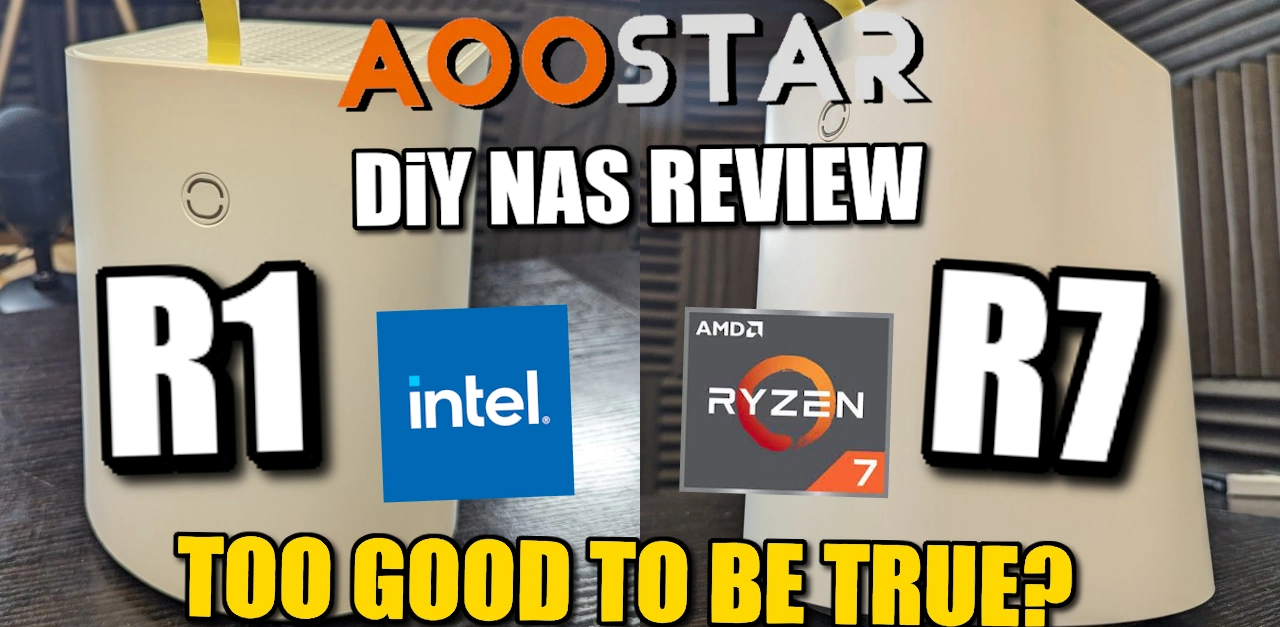



Bout this 3 months ago as an easy 2 bay NAS for offsite storage at the inlaws. Setup Unraid and everything was working fine… until 4 weeks ago. the non parity drive was showing as disabled. Went down there to trouble shoot. After reboot, can’t find any drive on the 2nd bay. Tried multple drives! Same! Ended up working through Amazaon to return. it was outside the return window, but within the 1 year warranty. Aoostar would not respond – so Amazon allowed me to return for a refund. Now going to try the Terramaster F2-424
REPLY ON YOUTUBE
I bought this device for 220€ and got it recently, and I can say that it performs just as you’d expect. it’s not the fastest machine and is clearly slower than my desktop PC with i3-14100 with faster parts, but it performs well enough to be used as a plex/jellyfin server. it currently runs 15 docker containers for me ranging from “arr”- stack, gluetun, pihole, plex, jellyfin, audiobookshelf, bazaar, etc and still has some juice left. I wouldn’t recommend it for multiple users, but for 2 people at home use it’s a perfect purchase. I also installed my own debian trixie 13 into it so you can install whatever OS you want.
positives:
– low power consumption
– easy to use, easy to expand storage
– great for beginners getting into homelabbing
– low price
– can play a 4k youtube video, but it feels a bit sloppy, like takes time to load
– n100 is actually strong enough in my opinion to be used as a minimalistic study PC. I did not try any games, and browsing was a bit slowish, but it got the job done, and according to some benchmarks it can run league of legends at 1080p 60-120fps
negatives:
– now, after 2 days of testing I can’t say much for sure, but my god the noise level is high. on a scale of 1 to 10, I’d say it’s a 3 or a 4. loud enough that you can’t really keep it in the same room without going crazy at some point, and I’m trying to figure out right now what parts I need to change to make it more quiet. but just so you guys know, it’s probably only a Aoostar R1 problem. thanks to it’s wifi I put the device in the kitchen where it doesn’t bother as much.
all and all I am happy with my purchase, because at 220€ you can’t really beat that. if you don’t need the HDD bays, you can save some money and go with a smaller mini PC.
REPLY ON YOUTUBE
You definitely need those 90W considering that enterprise HDDs demand up to 28W x2 = 56W (max), but you want to have this headroom.
25w(CPU) + 56(2xHDD) + 14W(nvme) + 3W(NICs) = 98W
No usb attached.
I would go with 12V 10A with this box if you want to use the full power it capable of.
REPLY ON YOUTUBE
I have this, and can’t find a way to get temps in Unraid, can’t get Dynamix System Temp to get anything
REPLY ON YOUTUBE
This is what the diy nas community was waiting for for the last 6000 years
REPLY ON YOUTUBE
Mine arrived and did not give a video.
REPLY ON YOUTUBE
Using this for a year+ and absolutely happy
REPLY ON YOUTUBE
A year and a half on, is there a better option? You set the agenda brilliantly: this, but with 10GB Ethernet and Gen4x4 M.2 (at least two, preferably four, maybe Gen4x2 would do, so long as it can saturate the 10GB Ethernet). And did the promised Proxmox build video ever get made? I could not find it!
REPLY ON YOUTUBE
Hello big brother how are you ? Hope everything is fine.
Ok I searched in google but Aoostar r1 or r7 is not available in my country. But I found Chatreey n150 nas in Ali Express. Would you please look into it if you have time and suggest me should I get it just for media home server? I will only use it for storage and some movies.
Also I see other nas like synology is triple the price in my country so I was thinking to get Chatreey n150 nas instead from aliexpress.
REPLY ON YOUTUBE
It’s loud as hell. 57db without physics hard drive.
REPLY ON YOUTUBE
Truenas
REPLY ON YOUTUBE
Mine,with 64gb ram and 1TB hard disk,freezing and restart.Also,i can’t see any video on net or from the mini pc because they are freezing too.
REPLY ON YOUTUBE
I will assume it’s Windows 11 Pro? 1) Enable Hyper-V 2) Install Docker for Windows. You can do everything everybody else does with docker in Linux. With a Windows GUI.
REPLY ON YOUTUBE
The wifi card slot can be converted to use nvme with a cheap ali xress adaptor, so 3x nvme and 2 HDD. I have the n100 version for now and it has 1 nvme + wifi conversion. Great nas if you need a 2 bay, but now the 4 bay is out and that one is even better amd version 4xsata 2x nvme and wifi (nvme) conversion. 400 usd barebone
REPLY ON YOUTUBE
I think it could be fun if they would of put windows server on it and put in two 10g nic cards.
REPLY ON YOUTUBE
Will this support 8tb nvme’s? Would you recommend nvme heatsinks?
Will it also support 22tb sata drives? Could you take out the wifi card and add in a smaller m.2 drive?
REPLY ON YOUTUBE
It is also available with 8gb ram/256gb ssd for £192.50 delivered from geekbuying after a voucher.
REPLY ON YOUTUBE
Can I install Opnsense directly on this ? Since it has two or dual Ethernet port I want to use it only as firewall running Opnsense, thanks
REPLY ON YOUTUBE
Arguing that it should have a USB-C PSU is beyond silly, every barrel connector ever made in the history of the world is better than USB-C for delivering power. The ONLY case where USB-C makes sense as a power port is on a laptop where it can run without the PSU connected and use the port for something else when it is running on internal battery.
REPLY ON YOUTUBE
was the followup video ever done? proxmox etc/
REPLY ON YOUTUBE
Did you ever do follow ups on these? I can’t find any.
You did do the WRT PRO when it appeared recently. That had a curious history after their talk of a 6+6 device, ended up as a 4+2. Although there’s stock at a couple of the alternative Chinese sites eg. banggood, Aoostar seem to have sold out of both the R1/7 & WRT a couple of times at least They’ve a new batch of WRT at the start of November.
REPLY ON YOUTUBE
This would fit my needs. Two fairly high capacity drives pooled using DrivePool, light Windows use as a NAS/Server replacement.
REPLY ON YOUTUBE
Great review, I have not been able to find, do you happen to know if the device supports drives with the power disable feature ( PWDIS )?
REPLY ON YOUTUBE
Does this motherboard support setting the two NVME drives to boot in RAID 1?
REPLY ON YOUTUBE
Got R7 version and to reduce noise it necessary to replace original FAN with a better one (Ive replaced it with ID-Cooling TF-9215 PWM) … and to reduce nose from plastic housing car sound insulation can be used … just few patches inside of the housing … It would also be a good idea to set up disk shutdown by timeout … and as a result I dont hear it … its almost silent … From time to time I only can hear less annoying (thx to car sound insulation) HDD starting when some network services is requested. Car sound insulation CHANGED it to a diff thing
REPLY ON YOUTUBE
If you want to reduce noise just use sound insulation for cars … two small pieces on pc case. I had noise from HDD 3.5 … when they starting to seek
i think the coolest thing is i can power it through usb-c, 45W IKEA SJÖSS charger does the job (R1):D
REPLY ON YOUTUBE
In terms of energy consumption, is better n100 option than amd ryzen?, thanks for your video.
REPLY ON YOUTUBE
If you want to 10gbe you could use one of the m.2.slots
REPLY ON YOUTUBE
Does anybody know if the M.2 or mPCIe sockets of this mini PC are compatible with Google Coral Edge TPU? The PCIe bus should be MSI-x compatible but of course there’s no datasheet so i’m looking for someone that has tested it. Cheers!
REPLY ON YOUTUBE
Thanks for your review I will buy this product
REPLY ON YOUTUBE
2-bay? Surely it’s no more than a toy?
REPLY ON YOUTUBE
This guy shows it working with usbc power. https://www.youtube.com/watch?v=PSVQZ8SHmZU&list=WL&index=64&t=624s
REPLY ON YOUTUBE
I bought the N100/no disk/no RAM version sold under a Chatreey brand name on AliExpress. But I am using Aoostar’s website for support, since that is slightly better than Chatreey’s.
1. The internal microSD card reader has a useless “Globally Unique Identifier (GUID)”, since manufacturer uses the same GUID for all sold devices. This is careless and makes the card reader unusable for people, who want to boot unRAID from it, since the GUID is blacklisted after the first person to buy this device and use it with unRAID has gotten the license tied to this GUID. Instead, we now must use a USB flash disk, which adds to the costs and makes an ugly thumb-drive stick out from the back. Could have been so nice… However, it is bootable, so that’s, at least, a plus.
2. The case of the device also creates a painful noise because it is resonating from either the hard disks or the fans. Holding it with both hands, each on one side, makes this frequency go away, but this is not a solution.
3. Plastic is on the cheap side throughout the whole design but bearable.
4. Today’s NVMe disks tend to get very hot. The space in the casing is too small to use a really good NVMe heatsink with heatpipes, like Thermaltake.
5. The BIOS is pretty nice with help strings, that make, mostly, sense and are explanatory. However, as it seems, the BIOS is only upgradeable from within Windows, there are some faint instructions on manufacturer’s website, that the download may be a WINPE environment, that needs to be copied to the root of a USB flash drive. However, no version information or history for the BIOS downloads exists!
6. Both of the LAN port’s orange LED lights are constantly flashing (I tried several cables). However, I have established a firm connection to the router and the internet (I am currently writing from the device in question). They do this as soon as the device gets connected to the power supply, even before switching it on. WOL only explains the online state of the LAN ports, but not the blinking.
I would rate this device as “better than nothing” and only if you can get it for $150 or below, but not more (I payed approx. $180). For me it replaced a WD MyCloud 4TB device.
REPLY ON YOUTUBE
Is it possible to remove the wifi module? To save some power? Also, those are 3.0 USB, not 3.2.
REPLY ON YOUTUBE
for home usage, htinking in to replace cloud usage, if you have a chance, would you recommend to get a Jonsbo N3 and build your own nas? or build something ready to go? thinking in longebity, also would you pay for Unraid or using Truenas ? in the other hand, do you know if there are 2.5″ nas hdd ?
REPLY ON YOUTUBE
Just ordered a barebones one and it should be on it’s way. Should be perfect to shuck two external Seagate drives and use this as my first NAS/ HTPC. Even though you mentioned no one would use this with Windows I guess will to start haha then maybe Synology DSM or some other nas software mostly for running a 24/7 Plex media server and local photos backup so I can finally rest my gaming pc.
REPLY ON YOUTUBE
Trying to decide if 5700u version for (35% more money) is worth it for future proph and more versatility… What do You think? It wil be used mainly as proxmox base (2x nvme for 5700u with zfs) with pfsense, jellybean, home assistant and unifi controller. In the future maybe will take a role as a homelab. I have a different machine as NAS and most of the network is 1Gbp
REPLY ON YOUTUBE
One of the Amazon reviews said he put in ECC, but didn’t elaborate. Does this thing really make use of ECC???
REPLY ON YOUTUBE
I have run into issues getting an IPv4 address configured in TrueNAS. Wondering if anyone else has experienced ths or if perhaps my unit has an issue?
REPLY ON YOUTUBE
even though there is an extra memory slot – the n100 spec on intel site says max support is 16GB RAM in single channel – no dual channel support it seems…
REPLY ON YOUTUBE
If only this system had 4 bays.. ???? (and was less ugly imho). Seems a great buy for the money though
REPLY ON YOUTUBE
When is the follow-up video going to be published? ????
REPLY ON YOUTUBE
Is the R1 a better device for Plex than the R7????
REPLY ON YOUTUBE
Hello, first of all, thank you! Your channel is so helpful.
So, I have a question: my setup is an AOOSTAR R7 running Proxmox, and TrueNAS SCALE running as a VM on Proxmox. My question is, should I configure GPU passthrough to my TrueNAS SCALE VM to leverage the benefits from the GPU, or is it not necessary? I have installed Jellyfin under the TrueNAS SCALE VM.
REPLY ON YOUTUBE
When is rhe plex testing comming ????!?
REPLY ON YOUTUBE
i think the Aoostar R1 with its Intel N100 might be better for transcoding, which is important for my Jellyfin/plex server… Do you happen to know about this or could show us a comparison? I want the R7 but i know that intel is king when it comes to transcoding..
REPLY ON YOUTUBE
Thank you for the review, now I’m fully confident to buy this.
REPLY ON YOUTUBE
I purchased one and intend to use as a Jellyfin/Plex server for personal use. I discovered that under Windows the Bluetooth 5 capability with the RTK 8852 BE Chip (Wi-Fi 6 Module CDW-C9852BE) does not work. Wifi 6 does work fine for wireless connectivity however. Windows device/drivers setup seems fine and no Bluetooth install errors in device manager, but transmit (not discoverable by other computers or devices running Bluetooth) or attempt to add Bluetooth devices like mouse or keyboard will not show up in Windows. I updated to the most recent 8852 drivers but still not working. Has anyone else who bought this unit tried Bluetooth and is it working?
REPLY ON YOUTUBE
I am a complete noob in all this. I am planning on buying this solution and running Proxmox with a pfsense VM for router needs for the house. Is this a good idea? Would I need extra equipment in the R1 to make this happen? A card with WAN and LAN ports?
REPLY ON YOUTUBE
careful, most of the offered n100 solutions that look like this product do not come with 2x SO-DIMM slot as stated in the video.
the product description on them states that N100 models have 1x SO-DIMM up to 32gb support and instead its the ryzen versions that are the ones with 2x SO-DIMM slots
REPLY ON YOUTUBE
I bought one. The sd card slot on the back is defective/non functional. A card cannot even be securely inserted. Other than that and the overheating its a good mini pc using it as such with windows. I added 2 22TB seagate drives without issues. However the graphics are less than standard as most movies are not watchable.
REPLY ON YOUTUBE
I don’t like the power button being in front.
REPLY ON YOUTUBE
Would it be crazy or stupid to desoldar the NIC there and replace them with 10G?
REPLY ON YOUTUBE
FIRE HAZARD!!
I ordered the AOOSTAR R5 in June 2023 from amazon and even though it seemed to be a reliable mini PC that can accommodate multiple storage drives, I am now unable to use it less than a year on. I primarily used it as a storage backup and had Plex setup to enable file sharing and playback across the household. This feature worked well. I was never able to get any of the folders on Windows 11 to show up on my network, and it most certainly is not a NAS substitute. To add, I have had this powered on since first setting it up and that would be needed for it to be able to share any files. Today while re-arranging my office I shut down the PC and unplugged it. A short while later I moved it to a new location in my office and plugged it back in, and that’s when I noticed that it wouldn’t power on. I tried multiple sockets with no success. I left it plugged in and left the room to grab a drink. A few minutes later I walk back into the office and the smell of electrical burning was very strong. I couldn’t determine where it was coming from and didn’t twig at first but the burning smell was coming from this PC. I have always used the included power brick and cable supplied. I am really horrified about this and it scares me to think that I could have left this unattended for a long period of time. Maybe I am over-reacting but I really question the build and reliability of this off brand mini PC. I spent over $300 on this. I will definitely never buy any off-brand electrical items again. Deeply disappointed and would caution other potential buyers.
REPLY ON YOUTUBE
this would be perfect for my home use. I run PLEX for serving out my content, collect content via PlayOn, and then store all my music/photos/documents. Throw 2 12TB Red Nas drives in and it would be perfect to replace my current nas using a Ryzen 5600G.
REPLY ON YOUTUBE
Bought this (5700U) from Aliexpress, barebones, £230.31 delivery was within 12 days from ordering. I was previously running a Aliexpress KingNovy mini PC but had to use USB drives (not ideal). Running unraid, all seems fine, if I could just get Jellyfin trancoding to work 🙁
REPLY ON YOUTUBE
Hello can you please do a video how to activate IGPU from Ryzen 7 5700u for Plex transcoding on this device, thanks
REPLY ON YOUTUBE
I think at this price point 10GBe ain’t a dealbreaker. If anybody buys this NAS due to budget constraints I’d guess they don’t have a 10GBe Router / Switches / PCI-e Card in their main Computer.
REPLY ON YOUTUBE
Greate video, I want to know the ideal power consumption cuz I will gonna buy it.
Thanks..
REPLY ON YOUTUBE
its sitting around £200 for a barebones..
Aside from a used unit, I can’t find any UK stockists, or express shipping options – I wonder if NASCompare is missing a business opportunity here!
REPLY ON YOUTUBE
wow, this is Tianbao or Tianbo NAS, they are a workshop brand based in Guangzhou China, and this one R7 has been out for a little more than a year.
The main problem is the cooling isn’t good enough as you mentioned in the video, and the drive bay isn’t very stable (loud noise)
They made a V2 version to improve the cooling and also a N100 version but I don’t know if you can get it in the UK.
REPLY ON YOUTUBE
Has anyone who’s bought one tried Plex? Just wondering how it is as it’s currently on offer on AliExpress. Thinking about just sticking a couple of 2.5″ 4Tb drives in it.
Just hoping that the Plex experience is good?
Thanks
REPLY ON YOUTUBE
You are simply the best. Congrats for your reviews ????.
REPLY ON YOUTUBE
There are USB Type-C to DC barrel jack adapters that have built-in voltage selectors if the PSU is PD 19-20V capable. You can replace the power brick with a beefier phone charger.
REPLY ON YOUTUBE
loving the pink F-91W
REPLY ON YOUTUBE
That would make a nice edge router +nas +Pi-Hole
REPLY ON YOUTUBE
I think 2 bays are very important as many many home users just can’t justify the cost of 4 or 8 bay drives and tons of expensive hard drives.
REPLY ON YOUTUBE
I think most people will use a 2 bay because most people are NOT rich, don’t have money for one NAS let alone one with 4-8 bays. And many people just need a solution for one drive with one redundant drive. The consumer. But i think most people these two bays are a real option and it’s not at all a waste. I think these companies abandon them cause they really don’t get the market outside of enterprise users. They don’t get the home plex users that’s not dirty rich.
REPLY ON YOUTUBE
“Rrrrrrrripe for VM deployment”… nope. AMD iGPUs can’t really be passed through.
REPLY ON YOUTUBE
Would love to see the video transcoding performance of this newer ryzen cpu.
REPLY ON YOUTUBE
Preview is misleading. Specs are listed for the N100 but the R7 model is shown. N100 has only 1 SODIMM slot and 1 NVME slot, where as the shown model has 2 SODIMM and 2 NVME slots. Gives the impression you get a dual NVME model for 200 bucks.
REPLY ON YOUTUBE
I’ve got one of these running Open Media Vault, as you said this will be many peoples first NAS/Mini PC type device. Setup has been easy, noise levels are perfectly fine in my study. Very happy with it so far, the N100 easily handles the Docker containers I am throwing at it.
REPLY ON YOUTUBE
Shame the links only go to US sites, how about some for UK (after all you are based in UK) the links you give take me to unrelated page on Amazon UK
REPLY ON YOUTUBE
2 bay for raid backup storage is a joke. you Must have at least four drives for failsafe Raid.. In order to do any Raid at all you need at least Two drives but if one of the two drives fail then you no longer have RAID or any storage. If in a Four drive RAID system, One drive fails. You still have RAID and all your data is safe.
THEMS THE RAID RULES.
REPLY ON YOUTUBE
When will you do your next SSD review?
REPLY ON YOUTUBE
0:10: ???? The video discusses the powerful features of a two-bay network attached storage system.
4:28: ????️ The video discusses a new system that fills the gap between pre-made NAS solutions and DIY open-source solutions, with a focus on design and flexibility for third-party software.
8:46: ????️ The video discusses the ports and connections of a powerful 2-bay device, highlighting its features and some omissions.
12:49: ????️ The video discusses the ports and connectivity features of Sony and Cup Mini PCs, highlighting the 10gb USB port, 4K HDMI output, and Wi-Fi 6 and Bluetooth capabilities.
16:57: ???? The video discusses the heating and performance of the R1 model running on the M100 device, with a focus on the AMD processor and integrated graphics.
21:06: ????️ The video discusses the use of Elgato for recordings and the exploration of CPU power control.
24:41: ???? The video discusses the performance and temperature of the drives connected to a device, highlighting concerns about temperature warnings and the warm hard drives.
28:33: ???? The video discusses the performance of SSDs and the disappointment of throttling for 2 * 2.5 GB on the rear.
32:24: ????️ The video discusses the limitations of a current hardware system and the potential for future improvements.
Recapped using Tammy AI
REPLY ON YOUTUBE
I’ve noticed on AliExpress that there’s an Athlon version as well. I’m guessing it falls between the N100 and the 5700U. Similar expansion to the 5700U in terms of RAM and NVME, but cheaper.
REPLY ON YOUTUBE
I like both this and the baby version, thanks for reviewing them! It’s definitely a contender if one of your biggest gripes is 10GBe networking, especially given that an add on card for Synology would cost a 33%-50% of the base price of this – and 2×2.5GBe is still considerably better than the old USRobotics 56K modem Synology are shipping by default… 🙂
REPLY ON YOUTUBE
Literally a mini PC with 2 NAS bays. Specs look good and super cheap! Too bad it’s only a 2 Bay.
REPLY ON YOUTUBE
I’ve just bought a Qnap TS-464 that, after a good 20 years with Windows, i just can’t get on with. Think I’ll sell that on and buy this, nice chassis AND Windows, could be the answer to my prayers.
REPLY ON YOUTUBE
Any chance you do some power consumption readings and comparisons on the follow-up video?
REPLY ON YOUTUBE
Supposedly it has a USB C port on it that you can use to power it if you wish. Have you tried powering it with a USB C brick?
REPLY ON YOUTUBE
I think Aoostar Poptart is a great nickname for these systems.
REPLY ON YOUTUBE
Proxmox+(pfSense, Synology NAS, (OS/w Emby server, Torrent downloader), Openwrt/w VPN) is how I would like to runt this router NAS… Really do wish it had 2 more SATA ports/bays and a 10 or 5gb ethernet port. So I guess I would attempt a 5gb usb adapter I already have, otherwise I may attempt pulling the wifi card and putting an adapter in that slot. I really want this router NAS..
REPLY ON YOUTUBE
Interested in the proxmox build with some idea of the performance of a NAS vm running on top. Should be able to run significant number of VMs on this. This device is not found on Amazon UK and the aliexpress links go the BEBEPC Official Store ?? So not available in Europe ?
REPLY ON YOUTUBE
Today, I got one of these. It was sold by Geekbuying under a T-Bao brand name. I ordered one with 16 gb RAM and a 500 gb ssd. First impression: the preinstalled Win 11 is very basic, indeed. AMD drivers are preinstalled. But no bloatware. During the initialisation of windows I was not asked for a Microsoft account. So it is obviously a customized installation. I added two Seagate Ironwolfs 4 tb — they were correctly discovered. After shutting down windows and attaching an external drive with Debian preinstalled I tested the speed of the hdd drives, initialised one drive and copied some chunky files to and fro. Everything works as expected. I watched a mp4 movie file. Neither the temperatures nor the noise level did bother me. So, all in all, a pleasant experience. So I expect Truenas and/or Proxmox will run fine on this machine.
REPLY ON YOUTUBE
Great NAS, but the “design” absolutely sucks.
REPLY ON YOUTUBE
Whatsabout put unraid on the SD Card and use all 4drives? What setup would be good in unraid 1 parity drive hdd, 1hdd drive, 1 nvme drive and 1 nvme cash?
REPLY ON YOUTUBE
I’m wondering if this is a good fit for a home server/nas/htpc with some game emulation.
REPLY ON YOUTUBE
5700U is far more powerful than the N100. Really cool.
REPLY ON YOUTUBE
Learning linux (so please be gentle) and getting confused with the way dd was used here, both the read and the write disk tests used if=/dev/ and of=/dev/null, I can see how that wil read from the disk, but which bit writes to the drive?
REPLY ON YOUTUBE
Very interesting device. I don’t think the 2.5Gb is that much of an issue here in the UK. 10Gb networking is not that common here.
REPLY ON YOUTUBE
Hey there. Any chance you could create a video that’s geared towards people interested in setting up NAS devices or homelab PCs primarily as AI platforms for things like stable diffusion or even AI object recognition in Photoprism to manage large content libraries? I work with a lot of designers who are very interested in setting up compact systems that can do things like generative art on their own private cloud that could be accessed from anywhere. They don’t really have the technical know how or time to tinker. This device seems like it would have the power and simplicity to be a good solution, but also open to seeing other configs that could do that. Guides for setting up gpu virtualization or just getting maybe specific apps in unraid configured currently would be nice.
I’ve built an AI tinker system based around the UNAS 410 chassis, Ryzen 5600G, and a Tesla P4 with a 3D printer blower mod, but I think it’s a bit too fussy to set up for the folks i mentioned.
Happy holidays and keep up the great work on the channel!
REPLY ON YOUTUBE
I just received my barebones N100 version of this – have yet to set it up, but I’m a little nervous. The build quality definitely feels lacking, and the Amazon reviews mention some huge issues. Hopefully it goes well!
REPLY ON YOUTUBE
The reviews on Amazon for n100 model are turning out to not be stellar. Makes me question buy in the n100.
REPLY ON YOUTUBE
I did order the Zimacube but my card apparently doesn’t like kickstarter and refused the payment so.. Current plan is Chuwi Corebox mini with a HDD bay for a jellyfin server and back ups. Any cons you can think of with this set up?
REPLY ON YOUTUBE
Love this video. I have an Dell R210ii that requires an urgent replacement due to power consumption and noise and I think this fits the bill. Having Unraid and be able to spin a couple of VM, have a ton of docker containers and be able to operate as a NAS also. Simplifies the complexities of XCP-NG and PCI Passthrough (for the HBA).
Only question is whether the ethernet ports are Intel or Realtek?
REPLY ON YOUTUBE
Mhhhh toasty as promised 😀 What would be fun of you intend to go with Proxmox, OpenWrt, PfSense and the like, would be to do it on the R7 and on the R1 at the same time
REPLY ON YOUTUBE
I would love to see Plex performance on this! I have been looking for a standalone Plex server and this looks like a great option!
REPLY ON YOUTUBE
Will be interesting If any one gets Xpenology to run well on it
REPLY ON YOUTUBE
Awesome video. Top drawer. I was just wondering what the power usage would be like idling with a 3rd party OS. Hope to see more on this model.
REPLY ON YOUTUBE
Openmediavault is a good alternative for home user without headhache.
REPLY ON YOUTUBE
The back of the device seems to imply USB-C power delivery input given the power symbol. Looking at the Amazon listing it also says “support 100w power suppoly” next to “type-c”… Wonder how reliable that is…
REPLY ON YOUTUBE
Looks like an ideal box to be use as a roon server. Does the BIOS offfer an option to do raid via the bios?
REPLY ON YOUTUBE
Could you review the ORICO MetaCube Pro/Metabox Pro NAS if they’re any good at all. tnx
REPLY ON YOUTUBE
I’m really impressed with this, thanks for reviewing. I think I would be more in the market with their bigger NAS you said they are currently developing
REPLY ON YOUTUBE
Imagine the Q or S selling 2bay nas with this spec , that probably price tag 800+ ????
REPLY ON YOUTUBE
This is the one I’ve been waiting on a review for!
REPLY ON YOUTUBE
Does the R1 auto-boot when it gets power from the wall? Or is there a setting in the BIOS to make it work? Or do you always have to manually switch it on?
If it can auto-boot, this would be a nice solution for off-site backups, but I would not want to leave it running all the time, so I’d want to remotely boot it up before backup transfer via smart plug remote switch, and then shut it down again after the backup transfer is complete.
If it doesn’t work, I’d rather build my own solution with dual core N50.
You will need to press the button or have wake on LAN router.
Yes it have the auto power on mode.
I would be interested to see how its bios and capabilities look like, and also real power consumption killawatt reading.
REPLY ON YOUTUBE
cool
REPLY ON YOUTUBE
0:00: ⚠️ The video provides a disclaimer about not including benchmarks and focuses on using the ustar R1 Naas for DIY Nas solutions.
3:56: ???? The video discusses the pricing and features of a budget-friendly NAS solution.
7:38: ????️ The video discusses the design and power management of a PC with a PCIe slot and a 90W PSU.
11:14: ????️ The video reviews a low-cost NAS storage device running Windows OS and discusses its features and limitations.
15:18: ????️ The video discusses the features of mini PCs and their evolving connectivity options.
19:16: ⚙️ The video discusses advancements in heat dissipation and design changes in small scale devices, particularly focusing on the Intel M100 processor.
23:25: ???? The video discusses the noise levels of a computer system and does not review the Windows 11 software.
27:53: ???? The video discusses using a third-party OS on a device instead of Windows 11 for better network capabilities.
31:50: ???? The reviewer is not impressed with the lesser-known brand’s new device, citing concerns about the software, limited network capabilities, and lack of USB power.
Recapped using Tammy AI
REPLY ON YOUTUBE
Hi, is this the same as you see in Alixxxxx? Is it worth the price over dyi?
REPLY ON YOUTUBE
Despite the listed specs for the N100 R1, I’d swear I saw a second M.2 slot and its mounting post in the video at 22:04.
REPLY ON YOUTUBE
You said that there are 2 RAM slots, but the N100 only supports one channel, so I think that there is something wrong with the board if they put 1 extra slot for nothing
REPLY ON YOUTUBE
kisluxbag has the exact same sacks as these, even pennyer.
REPLY ON YOUTUBE
Thanks. Please do more on this unit ,thanks.
REPLY ON YOUTUBE
Hope you had a Merry Christmas and thanks for all the work during the year. Here we are moving into Boxing Day.
REPLY ON YOUTUBE
Great internal parts, but the case form factor is totally unpractical. How would you stack 3 of them for a Proxmox cluster?
REPLY ON YOUTUBE
There’s also a AMD 5700U model
REPLY ON YOUTUBE
There’s also a AMD 5700U model
REPLY ON YOUTUBE
Nice unit to start out with, without a huge investment.
Yes, 90 watts might be a wee bit too much for the external powerbrick here but I rather have it oversized than undersized.
90 watts means you still have some decent headroom left and that powerbrick won’t get ran into the higher temperatures. (which is often the cause of the failures)
But in this particular case/application a 65 watt brick probably would have been sufficient.
That is in fact(!) one of the complaints I do have with the QNAP’s that do use external powerbricks, they do fail quite often.
And these are 90 watts.
(the seller on eBay sold a lot of replacements, go figure)
REPLY ON YOUTUBE
Nice unit to start out with, without a huge investment.
Yes, 90 watts might be a wee bit too much for the external powerbrick here but I rather have it oversized than undersized.
90 watts means you still have some decent headroom left and that powerbrick won’t get ran into the higher temperatures. (which is often the cause of the failures)
But in this particular case/application a 65 watt brick probably would have been sufficient.
That is in fact(!) one of the complaints I do have with the QNAP’s that do use external powerbricks, they do fail quite often.
And these are 90 watts.
(the seller on eBay sold a lot of replacements, go figure)
REPLY ON YOUTUBE
Please install unraid on it and do a Review
REPLY ON YOUTUBE
I would definitely be interested in how it performs as a Plex server.
REPLY ON YOUTUBE
It’s the CPU fan pwm and manageable from the os? Many Chinese PCs don’t let the os manage fan speed.
REPLY ON YOUTUBE
Regarding usb-c, my unit has it marked as data, display and power so it could be it does accept power delivery in. I haven’t tried it though
REPLY ON YOUTUBE
Noise might have been a bit less if you had installed the rubber feet or pads on the bottom so that vibrations would not have been transferred to the desk surface and allowed to resonate more. The difference might have been slight but perhaps it would have changed the character of the sound for the better.
REPLY ON YOUTUBE
I went for the 5700u which is now 300 usd plus $5 shipping to the UK, directly from aoostar
I think that’s the best value one
REPLY ON YOUTUBE
What a nice computer!
If I had seen your good video a week earlier, I would have bought this device as a Proxmox host.
Now I have an Asrock mini ITX also with an Intel N100. I soon discovered that the passive cooling of the CPU on that board falls short. While your Aoostar has a beautifully thought-out cooling system.
All in all, the Aoostar is very well thought out and I think you get a lot of value for money.
The N100 performs about three times as well as a J4125 and is three times more fuel-efficient.
Thank you for your good review!
Topton seems to sell the same computer btw.
REPLY ON YOUTUBE
Regarding the layout of the mobo stuck between the drives, it’s really similar to the WD Ex2 Ultra
REPLY ON YOUTUBE
Proxmox runs well on mine, but was a hell to install : v7.4 needing custom x11 settings files to start installation. Then update to v8. Idle consumption around 10W without any HDD
I also got it barebones, added 32GB crucial ddr4 and Sk Hynix P31 1TB nvme.
Even hardware transcoding works with Jellyfin, nice little home lab with excellent energy efficiency overall.
REPLY ON YOUTUBE
Do you think it would be possible to make a nas with cheap £20 1tb micro sd cards
REPLY ON YOUTUBE
Hardware haven, and alternative aliexpress listings say usb c supports PD… so much conflicting info going around on these devices
REPLY ON YOUTUBE
Thanks. Longing for next year evolution – N200 and USB C power supply I hope …
REPLY ON YOUTUBE
Thanks for dropping a Christmas Day video – hope you’re having a fun day! I would love to see some Jellyfin performance testing on this, if that would be something you might consider?
REPLY ON YOUTUBE
Thank you! Ordered one week ago – First Server / NAS which will look good beside my PS5 / TV. I‘ll use this for Proxmox (opnsense, pihole, plex, home assistant and docker…) – only downside of this device is nvme x1 speed – but this is probably the n100 has only 9 pcie lanes…
REPLY ON YOUTUBE
Could maybe function as a nice replacement for Apple’s discontinued AirPort Time Capsule.
Yes
Superb product, superb review.
I really want to see fully populated “total at the wall performance power consumption” and idle power consumption.
Also, how does this stack up as a transcoding streaming device against a N5105?
REPLY ON YOUTUBE
It is still fine for the minutes of intro, not going to skip it ????
REPLY ON YOUTUBE
Finding information really saves time.
REPLY ON YOUTUBE